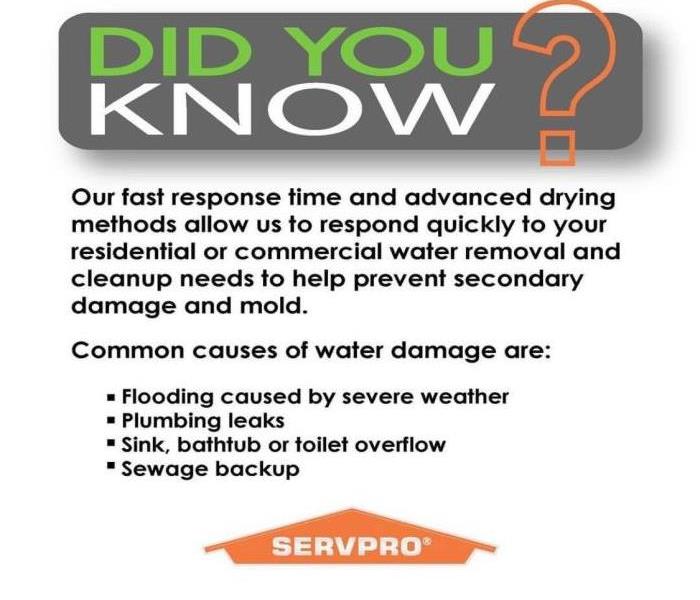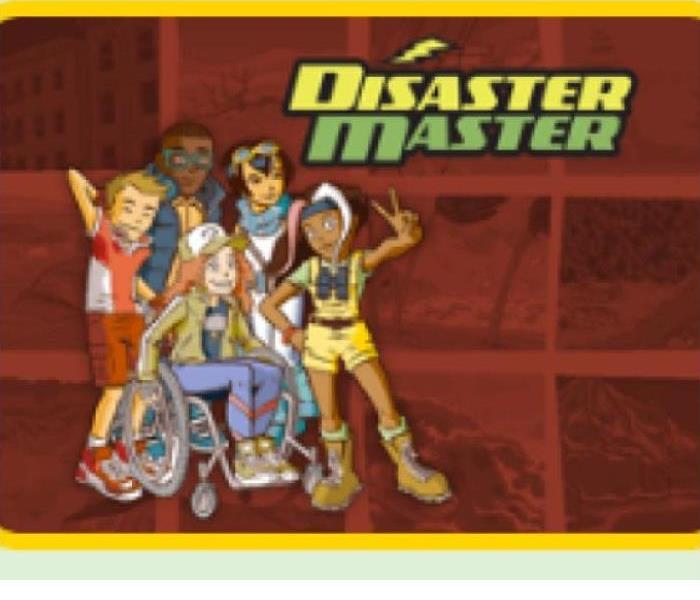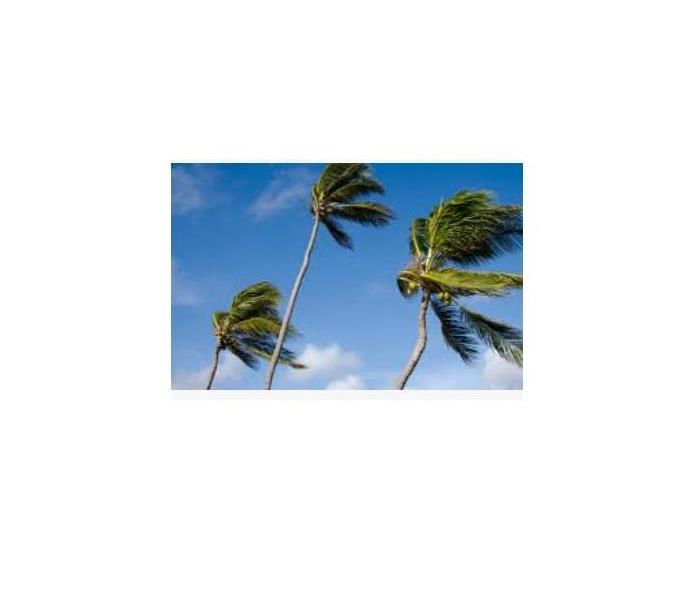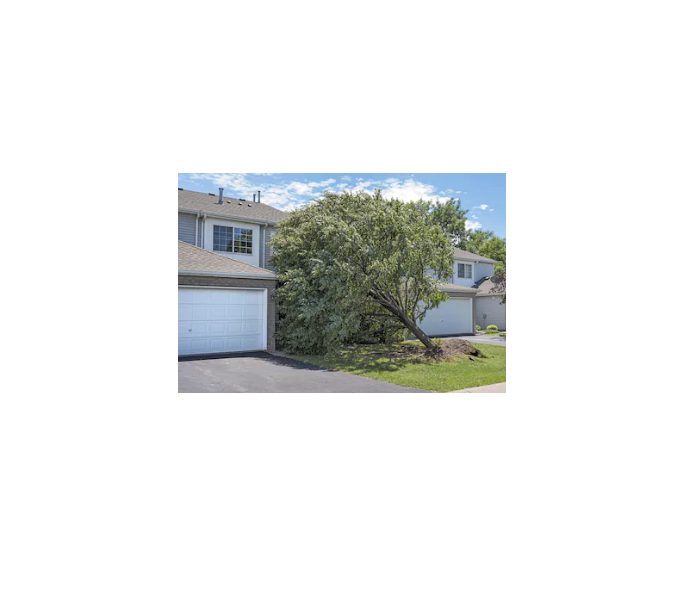Recent Storm Damage Posts
Who Helps with Storm and Flood Damage in Riverside?
4/27/2022 (Permalink)
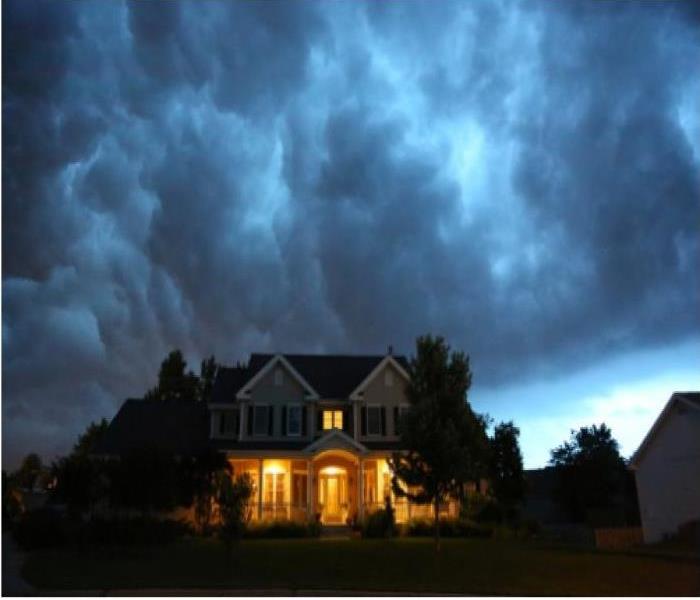 Storm and flood losses can both equally impact and threaten your home. Contact SERVPRO of West Riverside for your Riverside home storm damage.
Storm and flood losses can both equally impact and threaten your home. Contact SERVPRO of West Riverside for your Riverside home storm damage.
Our Professionals and In-House Contractors Provide Full-Service Restoration and Recovery after Flooding.
The combination of both storm and flood damage can be a compromising situation for your entire Riverside household. With so many of the restoration companies that you might choose only capable of addressing part of the problems that your home might face, it can be time and money-saving to choose a more comprehensive and full-service approach that our SERVPRO professionals can provide.
Post-disaster cleaning, repair, and restoration of storm and flood damage in Riverside homes begin the moment that our professionals first arrive at your damaged property. From your initial call to our emergency line, you get the full measure of our restoration and reconstruction team that can arrive together to begin vital mitigation and emergency services after structural damage and potential flooding occurs.
What Are the Emergency Services Offered by Professional Restorers?
Emergency services are the immediate tasks that our responding technicians and professionals begin upon arrival. While these actions might vary from one structure to the next, there are several common tasks that many can expect in a flood-damaged property. After substantial storm systems pass through the area, some of these same emergency services can help to clean up the debris and remove immediate risks so that our restoration technicians can get to work on recovering the property. Some of these emergency services include:
Temporary Construction Solutions – As you might expect, after a strong storm system passes through the area, much like we have seen with some weather events in recent years, structural damage is inevitable. By tarping roofs and sealing over structural breaches, we can more efficiently begin extraction and drying inside the house. Tree Removal – The same robust systems that can remove shingles and destroy portions of a standing structure can also knock down trees and break off limbs. Falling portions of trees can be destructive to your home and its roof. Our professionals can remove these limbs or trunks of trees to get the structural openings covered back over. Content Management – Your personal belongings are one of the priorities that need protection when our professionals first arrive at your home. We assess each item on a case-by-case basis, determining if we can restore it on-site or if off-site restoration and recovery are necessary.How Can Flooding Get Resolved Quickly?
When you recognize flooding has occurred in your home, it can be overwhelming to see. One of the struggles that homeowners face in this situation is taking the appropriate steps immediately to get the flooding cleaned up and extracted. The longer that you wait to address this moisture and standing water, the more destructive it can become to the house. When you choose our SERVPRO professionals, you are choosing:
Fast Extraction – Extraction is one of the vital elements of restoration and recovery after substantial water losses or flooding impact your home. Our professionals have capable extraction equipment like trash pumps and truck-mount extractors for continual, powerful removal of standing water.Efficient Drying – Drying your home after a flood can only happen after extraction and debris removal take place. Because water can migrate quickly through the house and into porous structural materials, drying involves a wide range of cutting-edge tools and equipment. Moisture Detection – The ability to check on the progress of our drying in real-time is one of the advantages of professional restoration. We can be continually moving drying equipment to provide the most efficient and thorough drying approach. What Extraction Tools Are Best?
Because extraction is such a pivotal element to the successful restoration of your home after a flood, the choice of the right equipment for the job becomes a vital decision. Choosing wrong can lead to longer or more costly restoration periods. Some of the ideal choices for this work include:
Submersible PumpsWet VacuumsCarpet WandsDoes Build Back Start Right After Restoration?
As a full-service restoration and recovery team, we have a full team of in-house contractors that can oversee the reinstallation of damaged materials. In most cases, reconstruction and repairs can begin as soon as mitigation completes. This seamless transition is one that can prevent West Riverside city longer recovery times or higher costs.
Storm and flood losses can both equally impact and threaten your home. In most situations, you can address both of these scenarios the same by contacting our experienced SERVPRO team. With our fast response and premier equipment, we can make it “Like it never even happened.” You can reach our experienced team 24/7 at (951) 351-8033.
Call Us When Disaster Strikes California!
3/30/2022 (Permalink)
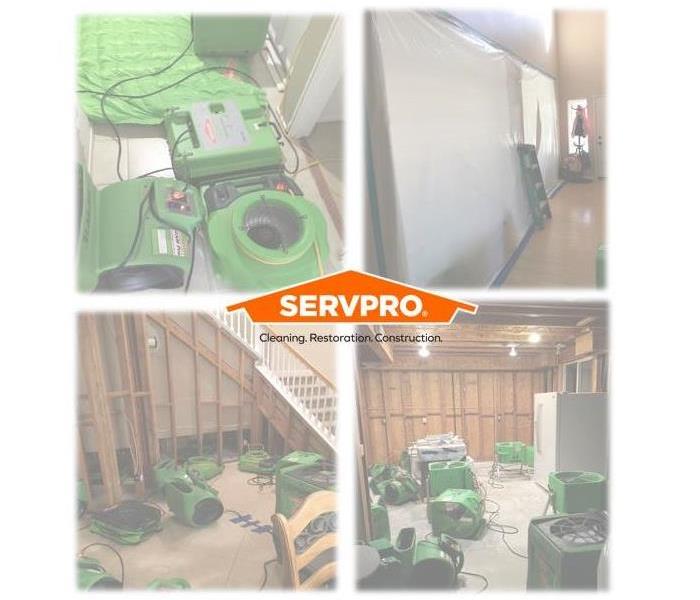 No job is too big or too complicated for our field technicians with the right approach, equipment, and attitude.
No job is too big or too complicated for our field technicians with the right approach, equipment, and attitude.
With decades of experience across the restoration services that we offer, we know how to help when every minute counts.
We have ready trailers and service vehicles prepared to roll out from our SERVPRO facility 24/7 to address the harsh effects of water, fire, storm, and mold losses. We have trained professionals to handle more specific recovery niches like air duct cleaning, biohazard cleaning, abatement, and reconstruction efforts. These talents, aiding in every facet of our customers' work, improve our efficiency and effectiveness in your home or business.
Storm
Storm damage in California homes is a situation that our SERVPRO Professionals can address. Properties I should remain prepared for fires, earthquakes, flooding, damaging winds and other conditions. Our ability to handle these situations is partly due to our commitment to the training and growth of our specialists, ensuring that each loss incidents gets technicians that can:
- Extract and dry up floodwater (WRT – Water Restoration Technician)
- Clean contaminated areas where they exist (Biohazard Cleaning)
- Deploy air movers and dehumidifiers for effective drying solutions (ASD – Applied Structural Drying)
- Clean Carpets and other flooring types (CCT – Carpet Cleaning Technician)
- Prevent microbial growth or address present colonization (AMRT – Applied Microbial Remediation Technician)
The other aspect that has allowed our disaster relief team to become so successful is our commitment to having the top-tier equipment that gets the job done quickly and correctly. SERVPRO keeps storm trucks stocked with a deep inventory of recovery and mitigation tools, including submersible pumps, engine-driven trash pumps, power washers, air movers, and dehumidifiers.
SERVPRO can offer a full-service approach amid a crisis so that our customers do not have to waste time finding secondary contractors to handle other aspects of their recovery. We have the skilled professionals to perform board-up and tarping services for your residence. We can also oversee full-scale reconstruction once mitigation completes in your Riverside property.
Water
We know how easily water loss incidents can develop, and that's why training our restoration technicians in this niche is a constant and continual process. The science of restoring water damage in homes is evolving and consistently changing. So our professionals have to move along with it – putting these new practices and equipment into use to help our customers with the most efficient and practical approach. Our commitment to customer satisfaction and the outcome of your loss incidents goes far beyond our IICRC training.
Our restoration team has access to equipment and machines that far exceed the limitations of conventional recovery tools. The truck-mounted water extractors that our SERVPRO team uses, for example, can handle the removal of thousands of gallons of water every day. Combined with multiple other impressive equipment pieces, this vehicle sets our professionals apart in water damage restoration for the greater Riverside area.
We also have the capability of addressing the massive loss of water damage for commercial properties and houses. 67 years of industry experience and a roster that features Commercial Drying Specialists (CDS) and those with WRT and ASD endorsements, no job is too big or too complicated for our field technicians with the right approach, equipment, and attitude.
Fire
Our team is responsible for many structures in this area alone; the possibility of fire damage is a persistent threat. Knowing the best approach to handle these conditions hinges on the severity of the situation and what materials, surfaces, and contents have become affected. Our IICRC-Certified Fire & Smoke Restoration Technicians (FSRT) and those with additional training in odor control and upholstery/carpet cleaning have access to equipment that can help our team restore loss incidents quickly.
Much of our efficiency in fire recovery stems from these advanced and cutting-edge machines. Soot removal and cleaning, for example, often fall to a combination of specially-formulated cleaning agents and products with automated surface scrubbers that can eliminate residues on surfaces.
Every minute counts in fire restoration. Our technicians obtain IICRC certifications and train to understand how fire damage in Coral Gables homes and businesses spreads and the best approach to overcome the damages.
Mold
Before our certified AMRTs can set up containment barriers and begin the often-intricate process of mold remediation in your Riverside home or business – our professionals must locate the source of the moisture and dampness. These conditions are likely to happen again without adequately identifying how the water damage facilitated mold growth.
You can count the swift response of SERVPRO of West Riverside City team in a crisis. Give our professionals a call anytime that you need us at (951) 351-8033.
Can Delicate Items Be Cleaned After Flood Damage?
1/26/2022 (Permalink)
 We not only restore the structure of your home but the treasured possessions inside.
We not only restore the structure of your home but the treasured possessions inside.
Not Everything is a Total Loss with Flooding in the City of Riverside – SERVPRO Knows How to Restore Treasured Items with Minimal Damage
Can Stains Be Removed from My Antique Chair Cover?
When homes experience flood damage in Riverside City, the initial focus is on emergency mitigation. Dealing with safety issues, water extraction, and drying out impacted areas is the critical focus. Floodwater is highly contaminated, and items may need to be disposed of, more so than in a home water intrusion. But some things may have peripheral damage, such as spots and stains that can be cleaned. Delicate items such as the upholstery on your antique chair can often be cleaned. While regular cleaning takes place, spot and stain removal is a bit different:
Stain and spot removal are specialized techniques.This type of cleaning occurs before cleaning the entire item.Spot cleaning may cause discoloration to the affected material.Cleaning the content thoroughly after spot cleaning can reduce changes and help the stain blend in. Isn’t a Spot and a Stain the Same Thing?
In most people’s minds, they would be the same if they even gave it much thought. However, there is a difference. A spot is produced when a component is added to the fiber of the material. Things like sugar, gum, or wax produce spots. A stain occurs when the grain of the material becomes discolored by something like wine or coffee. Our technicians are trained in understanding the cause and effect behind water damaged material, allowing them to apply the appropriate treatment.
How Do Items with Spots or Stains Get Treated?
Different types of soils require specific treatments. Fabric items such as upholstered furniture, carpets or rugs, or drapes are examples of often treated possessions. The kind of dirt on them plays a role in the cleaning agent used. Soils can include:
Water-soluble– Sugars and starches fall into this category. These get removed with a water spotting solution.Oil-soluble– Greases and tars come under this heading. An oil-based spotting cleaner gets used to remove these soils.Insoluble– Sand and skin cells cannot be dissolved. Vacuuming works best or suspension and extraction if necessary.Protein-based– These would include soils such as milk or egg. In this case, an enzyme-based product gets used.Color adding– Tannins, think tea or toner are examples. Dry brushing is employed, followed by a spotting agent. When dealing with the home contents that need spot or stain removal, the first step is to extract as much soil as possible. The faster the stain is addressed, the better the chance of repair. The material should ideally be dry, but our technicians advise on the best approach. If the damage is extensive and the item is wet, the technique may vary.
Restoring Your Possessions
Once the excess dirt has been removed from flood damaged items, determining the type of soil is necessary. The fiber content of the item is also defined. Understanding the soil type being dealt with and the fiber content is vital to ensure the right cleaning method gets employed. Before SERVPRO begins any cleaning of your items, we explain the process and the expected outcome. Then the best solvent for the job is chosen, and the item gets cleaned. All content is rinsed and dried, and restored as close to preloss condition as possible.
Flooding can result in devastation to your home and the contents. At SERVPRO, our goal is always to restore rather than replace it if we can. We sympathize with what our customers who have experienced flooding are going through. If we can save even a small portion of your treasured belongings, we are happy to do so.
Your Home is Important to Us
For around the clock professional flood damage, contact:
SERVPRO of West Riverside City
(951) 351-8033.
We not only restore the structure of your home but the treasured possessions inside.
What to do Before and After a Flood in Riverside
1/12/2022 (Permalink)
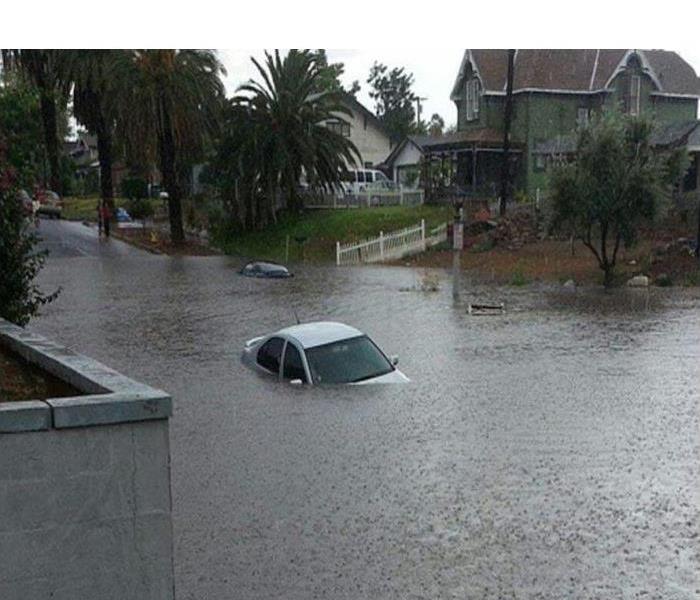 Remember that flash floods can occur suddenly, and miles from the source of water.
Remember that flash floods can occur suddenly, and miles from the source of water.
In Riverside flooding can happen anytime, but October to April are our rainiest months.
What to do before a Flood
Take steps to protect your home, family, and financial security throughout the year, and take extra precautions when flooding is predicted in your area.
The best way to protect your home and belongings from flood damage is to purchase flood insurance – don’t let your hard work be washed away.
Here are a few steps you and your family can take to be ready for flooding:
- Get Flood Insurance- Most homeowners insurance does not cover flood damage. Do an annual “insurance check-up” with your agent to make sure you have the right coverage and amounts of coverage.
- Know Your Risk- Look up your address in the Flood Map Service Center to learn if you live, work, or travel in areas that are prone to flooding.
- Take a Household Inventory- Take photos and videos of all major household items and valuables. Retain these documents in a safe place because they are important when filing insurance claims.
- Store Important Documents- Save copies of birth certificates, passports, medical records, and insurance papers in a safe, dry place. Keep original documents in a watertight safety deposit box.
Did you know?
When flooding is imminent or predicted, National Flood Insurance Program (NFIP) policyholders are eligible to receive up to $1,000 to purchase loss avoidance supplies like tarps, sandbags, and more.
Steps to minimize your flood losses
Minimize your potential losses from flooding by taking the following steps:
- Elevate and Anchor utilities- Elevate and anchor your critical utilities, including electrical panels, propane tanks, sockets, wiring, appliances, and heating systems.
- Clear Debris From Gutters- Make sure that you clear any debris from gutters and downspouts to avoid an accumulation of water.
- Elevate or Move Your Furniture- When flooding is predicted or imminent, move furniture and valuables to a safe place, such as an attic or the highest floor of your home.
When flooding is imminent – take care of your physical safety
When a flood is imminent or occurring, your first priority should be the physical safety of you, your loved ones, and your pets.
Stay alert by monitoring the local news and weather reports and sign up for emergency alerts. Have a communication plan ready in the event of a power outage.
In Riverside flooding can happen anytime, but October to April are our rainiest months. When there's a flood risk, the National Weather Service issues alerts. Sign up to receive emergency alerts.
Sand Bag Locations
Driving
Water depth can be difficult to judge, especially at night, and you may not see a road that is washed out too! Remember: Turn Around, Don’t Drown.
Outdoor Activities
Before going out to hike, bike, or another outdoor activity, check the weather forecast and information about the area. Is it prone to flash floods?
Have a back-up plan. After planning and travelling to your destination, it can be hard to decide to cancel your activity. If you have a back-up plan in an area that is known to be safer, you’re less likely to put yourself in a dangerous situation.
Watch for suddenly darkening skies or listen for thunder. Move to your back-up plan if these conditions start to develop.
Remember that flash floods can occur suddenly, and miles from the source of water. You may not be able to hear or see a storm that can cause a flash flood.
Have an escape plan and be prepared to ride it out, even by climbing a tree or other sturdy object. Some floods can take hours to recede, but even getting behind a jutting piece of canyon wall could protect you from the powerful waterflow.
When there's a flood risk, the National Weather Service issues alerts
Sign up to receive emergency alerts
Call SERVPRO of West Riverside City to Inspect your Property for water damage due to flooding. We can help determine if it's worth submitting a claim through your insurance.
Office 951-351-8033
We are open 7 days a week!
Open 24 hours a day!
Does Your Riverside Mobile Home Park Have an Emergency Preparedness Plan?
10/25/2021 (Permalink)
Do you live in one of the mobile home parks in Riverside, CA? Imagine a fire evacuation, is there clear direction on how you are to evacuate?
With the roads typically being narrow, some are cul-de-sacs how do you know. Are you aware of other exits that may be open during an emergency and which exit is closest to your home?
We will cover some of the things that can be discussed with your park manager if you are not aware of an Emergency Preparedness Plan.
The goal of the emergency plan is to maintain order, and reduce the risk to life, health, and safety of park residents and emergency services personnel in the event of an emergency. The Plan should identify essential evacuation routes that will be used in an emergency situation.
Residents must have access to information on evacuation routes as well as basic emergency preparedness information to enable them to take personal responsibility for themselves during an emergency. An important consideration in any emergency is the ability to coordinate with local responding agencies and personnel. It is imperative that
residents work in conjunction with and assist emergency response personnel as directed or instructed.
Evacuation of a Mobile Home Park
Once evacuation routes have been identified it is essential that park residents have access to this information. Evacuation information could be posted in the park clubhouse or other area within the park, and should be available to park residents before an emergency or disaster occurs. Having this knowledge will enable residents to take personal responsibility for themselves during an emergency.
There may be residents from the park who are willing to volunteer their time and to assist in the evacuation process. This will primarily be accomplished by using a current emergency phone contact list but in cases where phone service is not available or out-of-service, the information can be delivered door to door.
Evacuation considerations:
- Acquire and update emergency phone contact lists for next of kin notifications.
- Consider residents who may require assistance during an evacuation including but not limited to people with disabilities, or those who have access and/or functional needs.
− Residents can voluntarily provide specific limitations or health issues they may have which would require additional assistance during an evacuation.
- Inform other residents of the possibility of an evacuation or of an imminent evacuation during a natural or man-made disaster. Coordinate evacuation of other residents who are unable to transport out on their own.
- Inform/train other residents on procedures for securing their homes prior to evacuation such as gas shut off, water main shut off, electrical shut off, locking doors and windows, and leaving immediately to pre-determined locations.
- Organize and inform other residents of their evacuation route to take in leaving the park in a safe and orderly fashion.
- Conduct training and practice evacuation sessions.
Planning
The following list of questions and statements is only a sampling of items that could be identified and described in the park’s Evacuation Plan. These suggestions are provided as a tool to assist in the development of each parks customized Evacuation Plan.
- How many entrances and exits are there in the ark?
- Is there two way traffic accessible throughout the park?
- Are there concentrations of households who need special assistance to evacuate congregated in certain sections of the park?
- Would any section of the park be easier and quicker to evacuate first?
- Are there any fixed obstacles in the park that would hinder a sections evacuation route?
- If an entrance or exit is blocked, do you have an alternate evacuation route planned?
- In the event that all evacuation routes are disabled, is there a backup plan for evacuation such as a site for air lifting residents from the park?
- Adding information to the park plan that would inform residents how to prepare for an air lift rescue from their roof.
- Identification of the major safe sites in your community that emergency agencies use for evacuation.
- Supplying park residents with maps of the major routes out of the area.
- Safety issues that park residents can address before a disaster to make their homes safer (example: tie downs for LPG tanks; installation of smoke detectors, securing hot water heaters).
At a minimum, the Plan should include the following information: Essential evacuation routes; elevation of the park property, type of disasters common to your area; public warning signals used in the community; local emergency broadcast station frequency location; phone numbers to the local Red Cross chapter or other emergency agencies’ phone numbers.
Evacuation List of Residents by Section
The order of evacuation is for Section I to evacuate first, then Section 2 evacuates second and continues sequentially by Section number until the entire park has been evacuated. If the park contains numerous recreational vehicles, it is recommended that they maintain mobility functions for quick evacuation.
Evacuation Sites
Predetermined buildings/sites to evacuate to in the case of a Natural Disaster:
- Local High School Gymnasium
- Local Park Community Center
- Red Cross designated safe place
- Local Fair Grounds
- Another city or county government agency designated safe place
In the event of a disaster, which does not require evacuation of the entire park, the
designated site of evacuation within the park could be the community room or club house,
if available.
SERVPRO of West Riverside City is here to assist when disasters strikes. We're a phone call away at your time of need, night or day!
951-251-8033
International ShakeOut Day is always the third Thursday of October 21
10/20/2021 (Permalink)
 As always, you can hold your #ShakeOut drill when and where you want.
As always, you can hold your #ShakeOut drill when and where you want.
While COVID-19 has brought many uncertainties and challenges, one thing's for sure: ShakeOut is still happening this year!
As always, you can hold your #ShakeOut drill when and where you want. You can choose another date or several dates, and include people in multiple locations (home, work, or school), perhaps through video conferencing. It's a good idea to practice earthquake safety in different situations each year!
An earthquake is a sudden, rapid shaking of the ground caused by the shifting of rocks deep underneath the earth’s surface. Earthquakes can cause fires, tsunamis, landslides or avalanches. While they can happen anywhere without warning, areas at higher risk for earthquakes include Alaska, California, Hawaii, Oregon, Puerto Rico, Washington and the entire Mississippi River Valley.
Prepare Before an Earthquake
The best time to prepare for any disaster is before it happens.
Practice Drop, Cover, and Hold On with family and coworkers.Make an Emergency Plan: Create a family emergency communications plan that has an out-of-state contact. Plan where to meet if you get separated. Make a supply kit that includes enough food and water for several days, a flashlight, a fire extinguisher and a whistle.Protect Your Home: Secure heavy items in your home like bookcases, refrigerators, televisions and objects that hang on walls. Store heavy and breakable objects on low shelves. Consider making improvements to your building to fix structural issues that could cause your building to collapse during an earthquake. Consider obtaining an earthquake insurance policy. A standard homeowner’s insurance policy does not cover earthquake damage.Stay Safe During
If an earthquake happens, protect yourself right away:
If you are in a car, pull over and stop. Set your parking brake.If you are in bed, turn face down and cover your head and neck with a pillow.If you are outdoors, stay outdoors away from buildings.If you are inside, stay and do not run outside and avoid doorways.Protect Yourself During Earthquakes
1. Drop (or Lock)
Wherever you are, drop down to your hands and knees and hold onto something sturdy. If you’re using a wheelchair or walker with a seat, make sure your wheels are locked and remain seated until the shaking stops.
2. Cover
Cover your head and neck with your arms. If a sturdy table or desk is nearby, crawl underneath it for shelter. If no shelter is nearby, crawl next to an interior wall (away from windows). Crawl only if you can reach better cover without going through an area with more debris. Stay on your knees or bent over to protect vital organs.
3. Hold On
If you are under a table or desk, hold on with one hand and be ready to move with it if it moves. If seated and unable to drop to the floor, bend forward, cover your head with your arms and hold on to your neck with both hands.
Stay Safe After
After an earthquake, there can be serious hazards such as damage to the building, leaking gas and water lines, or downed power lines.
Expect aftershocks to follow the main shock of an earthquake. Be ready to Drop, Cover, and Hold On if you feel an aftershock.If you are in a damaged building, go outside and quickly move away from the building. Do not enter damaged buildings.If you are trapped, send a text or bang on a pipe or wall. Cover your mouth with your shirt for protection and instead of shouting, use a whistle.Check yourself to see if you are hurt and help others if you have training. Learn how to be the help until help arrives.Once you are safe, pay attention to local news reports for emergency information and instructions via battery-operated radio, TV, social media or from cell phone text alerts.
Register on the American Red Cross “Safe and Well” website so people will know you are okay.Use text messages to communicate, which may be more reliable than phone calls.Be careful when cleaning up. Wear protective clothing, including a long-sleeved shirt, long pants, work gloves and sturdy thick-soled shoes. Do not try to remove heavy debris by yourself. Wear a mask and maintain a physical distance of at least six feet while working with someone else. Use an appropriate mask if cleaning mold or other debris. People with asthma and other lung conditions and/or immune suppression should not enter buildings with indoor water leaks or mold growth that can be seen or smelled. Children should not take part in disaster cleanup work.Engage virtually with your community through video and phone calls. Know that it’s normal to feel anxious or stressed. Take care of your body and talk to someone if you are feeling upset.
A Disaster Preparedness Planning Guide for Owners and/or Residents in Riverside Mobile Home Parks
10/19/2021 (Permalink)
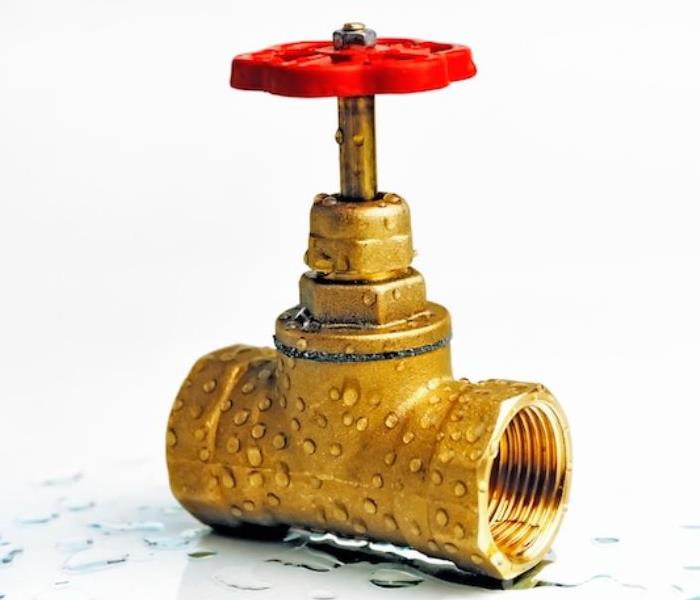 Do you know how to shut off damaged utilities?
Do you know how to shut off damaged utilities?
The most important feature of any home is something you probably do not see when you walk through the door.
But it could save your life. It is safety. Safety comes in all shapes and sizes: smoke detectors; fire extinguishers; escape routes; carefully maintained heating and electrical systems; and knowing what to do and where to go in case of fire, flood, or other disasters. The key to being prepared in the event of a disaster or sudden emergency is preplanning and practice drills.
Disaster Preparedness Emergency Plan
The next time disaster strikes, you may not have much time to act. Prepare now for a sudden emergency. Knowing what to do in an emergency is your best protection and your responsibility. Learn how to protect yourself and your family by planning ahead. To obtain more information, you may want to contact your local emergency management agency or civil defense office and the local American Red Cross chapter - be prepared to take notes.
You will need to gather the following information:
- Find out which disasters are most likely to occur in your area. Ask how to prepare for each disaster.
- Ask how you would be warned of an emergency.
- Learn about your community’s warning signals: what they sound like and what you should do when you hear them.
- Learn your community’s main evacuation routes.
- If needed, ask about special assistance for the elderly or disabled persons.
- Ask about animal care during and after an emergency. Animals may not be allowed inside emergency shelters due to health regulations.
Checklist of Emergency Procedures
Meet with your family and discuss why you need to prepare for disasters. Explain the dangers of fire, severe weather and earthquakes to children, the elderly, and individuals that may need special assistance. Plan to share responsibilities and work together as a team. The following may be used in creating your own Emergency Response Plan:
- Draw a floor plan of your residence and mark two escape routes from each room.
- Install safety features in your home, such as smoke detectors and fire extinguishers.
- Discuss what to do in an evacuation.
- Find the safe spots in your home for each type of disaster. Post emergency telephone numbers near the telephone.
- Instruct household members to turn on a battery powered radio for emergency information.
- Pick one out-of-state and one local friend or relative for family members to call if separated by disaster (it is often easier to call out-of-state than within the affected area).
- Teach children how and when to call 9-1-1 and a long distance contact person.
- Pick two meeting places: 1) a place near your home in case of fire; 2) a place outside your neighborhood in case you cannot return home after a disaster.
- Keep family records in a water and fire-proof container.
- Locate the main electric fuse box, water service main, and natural gas main shut off valve to your mobile home. Learn how and when to turn these utilities off. Teach all responsible family members. Keep necessary tools near gas and water shut-off valves. Turn off the utilities only if you suspect the lines are damaged or if you are instructed to do so. If you turn the gas off, you will need a professional to turn it back on.
- Take a basic first aid and CPR class.
- Prepare a disaster supply kit.
If Disaster Strikes
- Remain calm and patient. Put your plan into action.
- Check for injuries; give first aid and get help for seriously injured.
- Listen to your battery powered radio for news and instructions.
- Evacuate if advised to do so. Wear appropriate clothing and sturdy shoes.
- Check for damage to your home - use a flashlight only. Do not light matches or turn on electrical switches, if you suspect damage.
- Check for fires, fire hazards and other household hazards.
- If you are remaining in your home, sniff for gas leaks, starting at the hot water heater. If you smell gas or suspect a leak, turn off the main gas valve, open windows, and get everyone outside quickly.
- Shut off any other damaged utilities.
- Clean up spilled medicines, bleaches, gasoline and any other flammable liquid immediately.
Remember to:
- Remember to confine or secure your pets.
- Call your family contact - do not use the telephone again unless it is a life threatening emergency.
- Check on your neighbors, especially elderly or disabled persons.
- Make sure you have an adequate water supply in case service is shut off.
- Stay away from downed power lines.
SERVPRO of West Riverside City has years of experience with water and fire damage. We have also handled water damage within mobile homes and we understand that they are not your standard stick home. Call us if you experience an emergency. We are here to help!
SERVPRO of West Riverside City
951-351-8033
How To Prepare for Disaster on a Budget?
9/13/2021 (Permalink)
 Natural disasters don’t wait for a convenient time. Preparing for them shouldn’t wait either.
Natural disasters don’t wait for a convenient time. Preparing for them shouldn’t wait either.
National Preparedness Month
Week 3 September 12-18: Low-Cost, No-Cost Preparedness
Natural disasters don’t wait for a convenient time. Preparing for them shouldn’t wait either.
If you are on a tight budget, there are several steps you can take that won't cost anything or that you could coordinate with a low budget. Here are some tips from Ready.gov:
Alerts
Start by signing up for alerts, safe-guarding important documents, and taking other low cost and no cost preparedness actions to lessen the impact of disasters and emergencies for you and your family.
Preparedness Products
Download or order your free preparedness products to help your family plan and prepare for the next emergency.
www.ready.gov/publications
Evacuation Drills
Drills aren’t just for your toolbox. Practice emergency drills with your family regularly. Kids already do this at school, why not implement them on a yearly basis at home.
Have a Communication Plan
Emergencies can happen anytime, and less than half of American families have a communication plan.
Ready.gov provides downloadable resources that are free! Print out a Communications Plan and fill it in with your family.
Plan ahead:
www.ready.gov/kids/make-a-plan
Prepare with Kids
Make preparing fun for kids! Go on a scavenger hunt around your house for items you already have to add to your disaster supply kit. Follow this list: www.ready.gov/kit and see how many items you can check off!
Be aware of disasters in your area
Know what disasters and hazards could affect your area, how to get emergency alerts, and where you would go if you and your family need to evacuate. Visit: www.ready.gov/be-informed.
Here are some tips to help you put together a budget friendly emergency kits
- Go to a dollar store. Here you can find kitchen items, first aid, cleaning supplies, lighting, and water
- Look for grocery food sales- buy 10 with a discount, canned goods are often on sale and use coupons.
- There are many budget grocery stores where you can find many items on your list.
- Buy in bulk for personal items.
- Purchase items when not in high demand
- Buy throughout the year.
- Use what you have at home, soda bottles can be cleaned appropriately and filled with water.
- Purchase off-brand items.
- Purchase electronic emergency supplies on eBay or Amazon
Riverside, Are You Ready for a Disaster? Prepare Now During National Preparedness Month!
9/1/2021 (Permalink)
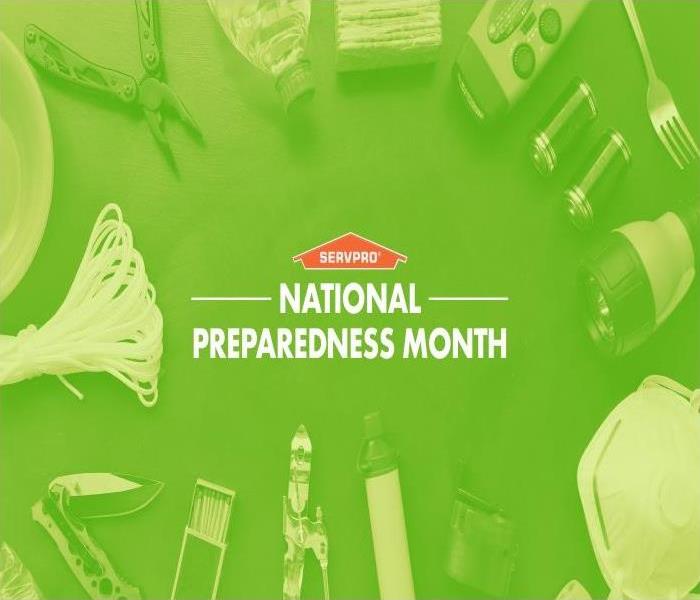 "Prepare to Protect” - Preparing for disasters is protecting everyone you love.
"Prepare to Protect” - Preparing for disasters is protecting everyone you love.
"Prepare to Protect”
Preparing for disasters is protecting everyone you love.
National Preparedness Month (NPM) is an observance each September to raise awareness about the importance of preparing for disasters and emergencies that could happen at any time. The 2021 theme is “Prepare to Protect. Preparing for disasters is protecting everyone you love.”
Why is it so important to be prepared? We are facing disasters more frequently. Not only natural disasters but disaster in our own home or business can happen at anytime.
Wildfires-2021 Fire Season Outlook
While wildfires are a natural part of California’s landscape, the fire season in California and across the West is starting earlier and ending later each year. Climate change is considered a key driver of this trend. Warmer spring and summer temperatures, reduced snowpack, and earlier spring snowmelt create longer and more intense dry seasons that increase moisture stress on vegetation and make forests more susceptible to severe wildfire. The length of fire season is estimated to have increased by 75 days across the Sierras and seems to correspond with an increase in the extent of forest fires across the state. NIFC predicts portions of the Coast Ranges, Sierra, and Cascades in California increasing to above normal fire danger in June and July and continuing through September.
Hurricanes
Hurricane Ida just made landfall in Louisiana, it was more powerful than Katrina exactly 16 years ago to date.
Katrina first made landfall early on August 29, 2005, as a Category 3 storm with maximum winds of about 125 mph near Buras, Louisiana, the National Hurricane Center said. It had been a Category 5 storm in the Gulf of Mexico and weakened significantly before making landfall, but that prior strength meant that it created a very high storm surge.
Earthquakes
Earthquaketrack.com provided these statistics as of 8/30/21:
California, United States has had: (M1.5 or greater)
- 28 earthquakes in the past 24 hours
- 224 earthquakes in the past 7 days
- 885 earthquakes in the past 30 days
- 11,314 earthquakes in the past 365 days
*Insurance Information Institute calculations, based on ISO®, a Verisk Analytics® business, data for homeowners insurance claims from 2015-2019
Insurance Claims
In additional to natural disasters, there are the disasters that occur at home due to damage caused by fire and water. These are sobering statistics. These same causes can also impact your business!
Homeowners Insurance Claims Frequency*
- About one in 20 insured homes has a claim each year.
- About one in 40 insured homes has a property damage claim related to wind or hail each year.
- About one in 50 insured homes has a property damage claim caused by water damage or freezing each year.
- About one in 365 insured homes has a property damage claim related to fire and lightning.
- About one in 425 insured homes has a property damage claim due to theft each year.
- About one in 1,440 homeowners policies has a liability claim related to the cost of lawsuits for bodily injury or property damage that the policyholder or family members cause to others.
*Insurance Information Institute calculations, based on ISO®, a Verisk Analytics® business, data for homeowners insurance claims from 2015-2019
How can we prepare our families and Business'?
Ready.gov has provided weekly themes. Review these with you family. Make everyone aware of yur family or business emergency plan. Schools hold fire evacuation and earthquake drills. Each family can plan to do the same. Ready.gov provides tools and resources to help with your planning. We will blog about the themes each week!
Weekly Themes
Each week in September, the campaign will focus on a different aspect of preparedness for individuals, families and communities.
Week 1 September 1-4: Make A Plan
Talk to your friends and family about how you will communicate before, during, and after a disaster. Make sure to update your plan based on the Centers for Disease Control recommendations due to the coronavirus.
Week 2 September 5-11: Build A Kit
Gather supplies that will last for several days after a disaster for everyone living in your home. Don’t forget to consider the unique needs each person or pet may have in case you have to evacuate quickly. Update your kits and supplies based on recommendations by the Centers for Disease Control.
Week 3 September 12-18: Prepare for Disasters
Limit the impacts that disasters have on you and your family. Know the risk of disasters in your area and check your insurance coverage. Learn how to make your home stronger in the face of storms and other common hazards and act fast if you receive a local warning or alert.
Week 4 September 19-24: Teach Youth About Preparedness
Talk to your kids about preparing for emergencies and what to do in case you are separated. Reassure them by providing information about how they can get involved.
Please follow us on social media for timely tips and ways to keep your loved ones and business ready for any type of emergency.
Instagram- SERVPRO West Riverside
Facebook- SERVPRO West Riverside
Twitter- SERVPRO West Riverside
Please check out our Website for more tips on:
Water Damage
Fire Damage
Commercial Damage
Riverside County Experienced 2 weeks of Summer Thunder Storms and Flash Flood Warning
8/30/2021 (Permalink)
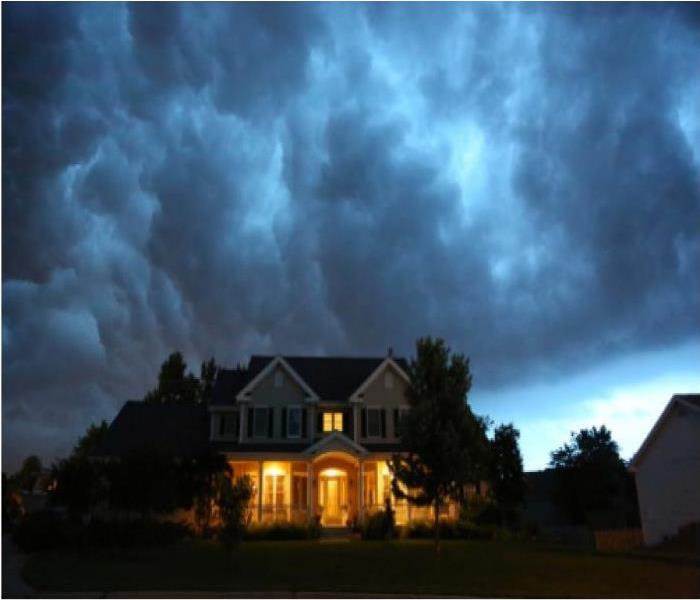 What if Riverside is hit with a random Thunder and Lightening Storm? Are your prepared? Do you know who to call should you experience a water leak?
What if Riverside is hit with a random Thunder and Lightening Storm? Are your prepared? Do you know who to call should you experience a water leak?
Is this common for Riverside County? Not really! Spectrum News 1 Reports:
What You Need To Know
- Summer thunderstorms are not common in Southern California
- Summer storms most often occur in the mountains
- Some rare, tropical-fueled storms bring significant rain
- Generally, summer thunderstorms don't generate much rainfall for SoCal
What if Riverside is hit with a random Thunder and Lightening Storm?
Prepare for Thunderstorms & Lightning
Know Your Risk
Know your area’s risk for thunderstorms. In most places they can occur year-round and at any hour. Sign up for your community’s warning system. The Emergency Alert System (EAS) provide emergency alerts.
Strengthen Your Home
Cut down or trim trees that may be in danger of falling on your home. Consider buying surge protectors, lightning rods or a lightning protection system to protect your home, appliances and electronic devices.
Make an Emergency Plan
Create an emergency plan so that you and your family know what to do, where to go and what you will need to protect yourselves from the effects of a thunderstorm. Identify sturdy buildings close to where you live, work, study and play.
Stay Safe During Thunderstorms & Lightning
If you are under a thunderstorm warning:
- When thunder roars, go indoors! Move from outdoors into a building or car with a roof.
- Pay attention to alerts and warnings.
- Avoid using electronic devices connected to an electrical outlet.
- Avoid running water.
- Turn Around. Don’t Drown! Do not drive through flooded roadways. Just six inches of fast-moving water can knock you down, and one foot of moving water can sweep your vehicle away.
Riverside County is prone to flash floods and high winds that could make driving challenging.
Stay Safe After Thunderstorms & Lightning
- Pay attention to authorities and weather forecasts for information on whether it is safe to go outside and instructions regarding potential flash flooding.
- Watch for fallen power lines and trees. Report them immediately.
Take an Active Role in Your Safety Go to Ready.gov and search for thunderstorm, lightning, or hail. Download the FEMA app to get more information about preparing for thunderstorm, lightning, or hail.
If you experience water damage from heavy down pour, or wind has damaged your roof. We are here to help! 24 hours a day 7 days a week.
SERVPRO of West Riverside City
951-351-8033
Building Safety Month-Disaster Preparedness
5/26/2021 (Permalink)
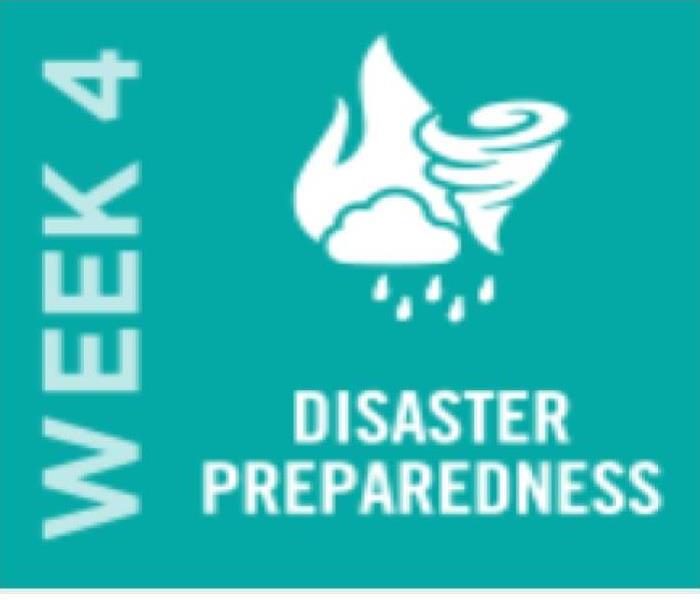 Natural disasters are increasing in severity and frequency. Advance planning supports a faster recovery in the aftermath of a disaster
Natural disasters are increasing in severity and frequency. Advance planning supports a faster recovery in the aftermath of a disaster
WEEK FOUR // May 24–31, 2021
Below are some resources the International Code Council has to help you prepare your family and protect your home from natural disasters.
Natural disasters are increasing in severity and frequency. Advance planning for devastating events like hurricanes, floods, snowstorms, tornadoes, wildfires and earthquakes helps individuals and communities increase the health and safety of their population during a disaster, protects the local tax base, ensures continuity of essential services and supports a faster recovery in the aftermath of a disaster.
Prepare Your Family
Here are a few tips to follow when preparing your family for any emergency.
- Determine your risk. Identifying and understanding possible
hazards and emergencies is the first step in preparing for natural disasters. - Consider incorporating a safe
room in building plans and improvements. A safe room is a hardened structure specifically designed
to meet FEMA criteria and provide near-absolute protection in extreme weather events, including tornadoes
and hurricanes. - Sign up for your community’s warning system. The Emergency Alert System and National Oceanic and Atmospheric
Administration Weather Radio also provide emergency alerts. - Develop a family disaster plan that
includes a list of food and water supplies needed for each member of your family and supplies for your pets.
Make copies of important documents like insurance policies, the deed to your home, and other personal
papers, important phone numbers and a home inventory. - Store important documents in a waterproof container and create password-protected digital copies.
- Review your evacuation route and emergency shelter locations
with your family. Options for evacuation would include staying with friends and relatives, seeking
commercial lodging or staying in a mass care facility operated by disaster relief groups in conjunction with
local authorities. - Taking shelter is critical in times of disaster. Sheltering in
place is appropriate when conditions require that you seek protection in your home, place of employment or
other location where you are when disaster strikes. - Review your plan regularly. If you make changes that affect the information in your disaster plan, update it
immediately. - Visit FEMA’s Prepareathon! to learn more about how to
prepare for earthquakes, floods, hurricanes, tornadoes, wildfires and winter storms. Get Involved to help prepare your family and community.
Protect Your Home
The power of natural disasters can be overwhelming. While you can't necessarily stop them from happening, there are steps you can take to increase your home's chance of survival, even in the face of the worst that Mother Nature can dish out. Protecting your home can range from taking simple measures like protecting windows or elevating appliances, to more complete building retrofit measures. See Additional Information and Resources below for links to hazard-specific guidance on protecting your home.
Several lines of insurance are available to cover financial damage from various hazards. To learn more about protecting your home financially through insurance, see FLASH’s Homeowner’s Insurance Guide to Natural Disasters.
Flood insurance can be the difference between recovering and being financially devastated. Just one inch of water in a home can cost more than $25,000 in damages. The average flood insurance claims payment to homeowners was about $90,000 from the Baton Rouge floods in 2016 and $65,000 for Superstorm Sandy that struck the Northeast in 2012.
FEMA's Individual Assistance Program, during times of federally-declared disasters, can provide financial assistance for home repairs, rental assistance, and other needs in the U.S., but the average payouts are much smaller, on the order of $6,000 to $8,000 per household — why risk it? For more information on flood insurance, visit floodsmart.gov.
Local Experts Are in Your Corner When You Need Home Restoration | SERVPRO of West Riverside City
2/17/2021 (Permalink)
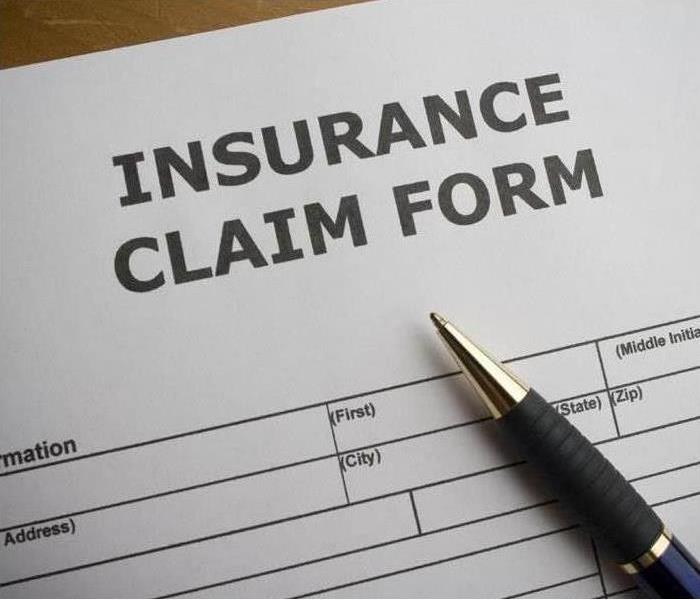 The sooner they can get the repair process started, the better the outcome is likely to be.
The sooner they can get the repair process started, the better the outcome is likely to be.
Every homeowner who files an insurance claim for home repair and restoration in 2021 will have one thing in common. What is it?
The sooner they can get the repair process started, the better the outcome is likely to be.
Homeowners' insurance claims vary widely in type and severity. Sometimes they’re from severe weather issues, like wind, hail and rain. They can also be caused by home accidents and appliance malfunctions.
The level of damage can vary, too. Sometimes homeowners need help repairing basement water damage or repairing mold damage. In other cases, the repairs and restoration work needed is more extensive.
Why Timing Matters
So, you may be wondering why starting early to repair damage to your home is so important.
Some types of home damage only grow worse over time. And the process progresses faster than you might expect.
For example, water damage can cause wood to warp within days. And the smoke, soot and water damage resulting from a fire worsen over hours and days. You can even notice the first signs of mold within a few hours. The longer these problems persist, the more difficult it is to remediate and repair them.
Move Fast When You Need Home Restoration
Your local SERVPRO team understands why it’s so important to get your home restoration process moving quickly. We’re always prepared to help you when an emergency arises.
You can reach out to our team at any time when you need home restoration and repairs. We’ll answer 24⁄7 to help you get the process started. You can trust us to be here when you need our help.
Beyond speed, there are plenty of other reasons, so many residents trust us to do their restoration work.
Our technicians are educated experts. Our technicians are passionate about providing the best services and work possible. That means they’re consistently going through training and earning certifications. They bring that knowledge to work on your home.
Our teams use proven, leading-edge technology. We’re connected with a nationally known and trusted brand. That means we have access to some of the best restoration technology available today.
We are a local business. We are members of the local community. That means when you call us, you’re calling friends and neighbors who are ready and prepared to help you when you reach out.
If your home is damaged due to fire, water or any other cause, you can always count on us for restoration assistance. We have teams who are available 24⁄7 in the event of an emergency. Contact us at any time to learn more about our restoration services and how we can help your family.
5 Ways to Keep Safe During Lightning Storm
2/10/2021 (Permalink)
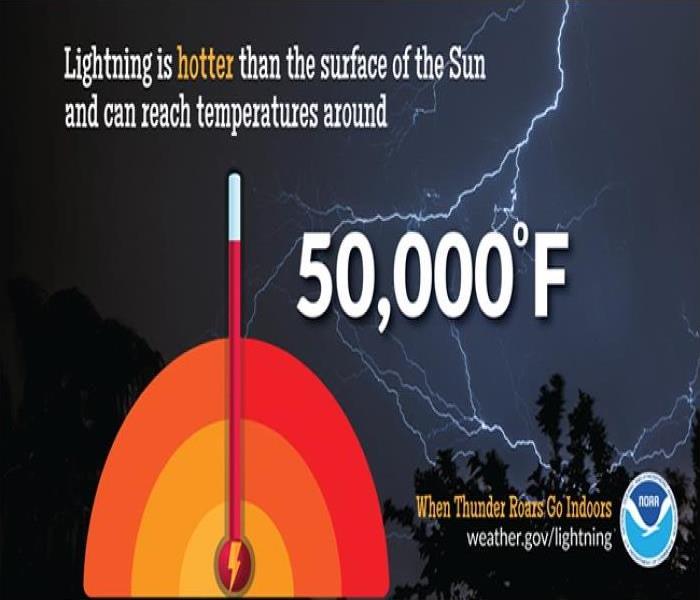 Lightning can be very dangerous, Call us if you have questions or are impacted by lightning or flooding. We're here to help!
Lightning can be very dangerous, Call us if you have questions or are impacted by lightning or flooding. We're here to help!
Each year in the United States, there are about 25 million cloud-to-ground lightning flashes and about 300 people struck by lightning. ¹?
Those are some sobering statistics you may want to keep in mind the next time you are trying to decide whether to play one more hole of golf or hike an extra mile when a potential storm may be brewing.
While summer is commonly known as the peak season for thunderstorms and lightning, such storms can strike any time and in almost any location year-round. The following guide and tips can help you and your loved ones stay safe and secure should you be caught in a lightning storm.
- How Should I Protect Myself?
It is important to understand that there is no safe place outside during a lightning storm. If thunderstorms are expected, you should stop any outdoor activities quickly — even if you are still mowing the lawn or enjoying a picnic. Many lightning casualties occur because people fail to seek shelter soon enough. Keep an eye on local weather conditions and have a plan if thunderstorms are expected. Your home’s best protection against a lightning strike is a lightning protection system. In order to find out more you can contact a certified lightning protection specialist for information.
- What if I am Outside During a Storm?
As soon as you hear thunder, stop all outdoor activities and get into a building or a hard-topped vehicle for safety. It may be tempting to get into a golf cart or a lean-to, but those will not provide adequate protection. If you absolutely cannot get to safety, try to stay away from open fields, hilltops, tall trees or other tall objects. Go to the lowest place possible, such as a ravine or valley, and squat in a baseball catcher’s position — with your heels touching, ears covered, and head between your knees. Minimize contact with the ground and do NOT lie flat. You should avoid water and anything metal, such as golf clubs or bicycles.
Exit the road or highway you are on and park in a safe location. Stay in the vehicle and turn on emergency flashers until the storm subsides. Avoid touching metal or other surfaces that can conduct electricity.
You may think that watching television or shopping on-line are good ways to pass the time during a storm, but your best bet is to unplug televisions, computers and any other high-value electronics well before the storm hits. Once the storm begins, do not touch any electrical equipment or cords, including corded phones. It is OK to use cellular or cordless phones during the storm. Be sure to stay away from windows and doors and do not go on porches. Also avoid taking baths or showers during storms. Water is a conductor of electricity so if a lightning strike hits your house during a storm, it may travel through water and shock you in the bath or shower.
- What if My House is Hit by Lightning?
If you think your home has been struck by lightning call 911 immediately and evacuate if you see fire or smoke. You may want to ask your local fire department to check for hot spots in your walls. If you use gas for heating and cooking, contact your gas company or a licensed contractor to conduct a leak test before re-entering your home. Gas system components have been known to sustain punctures as a result of direct or nearby lightning strikes.
Sources:
¹NOAA, http://www.weather.gov/lightning
Contact SERVPRO of West Riverside City
We can help when storms hit! Whether its damage from lightning, rain, wind, or flooding we have the knowledge and experience to help.
Call us 24/7
951-351-8033
Flood Insurance, what you should know living in Riverside County
1/20/2021 (Permalink)
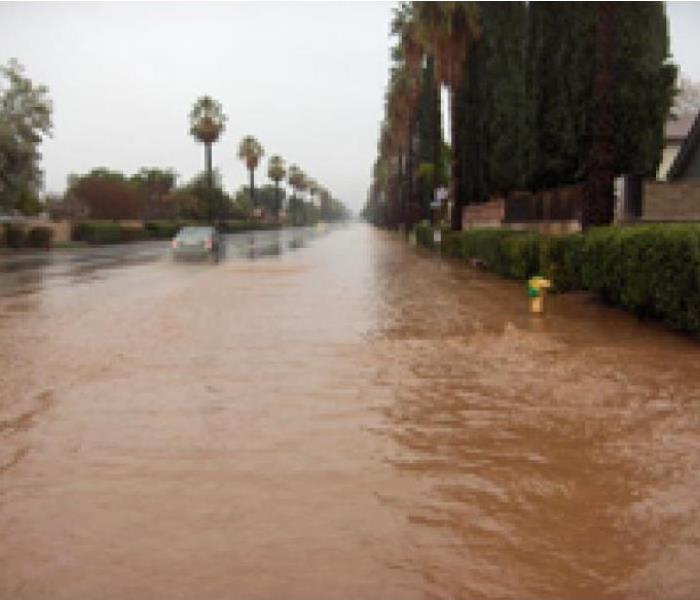 It may be necessary to purchase flood insurance policy to protect your investment from floods.
It may be necessary to purchase flood insurance policy to protect your investment from floods.
Many do not realize that flood damage is not typically covered by homeowners’ insurance policies, so it’s important to have an understanding.
We hope this information serves as a helpful resource.
It may be necessary to purchase flood insurance policy to protect your investment from floods. Just because you haven’t experienced a flood in the past, doesn’t mean you won’t in the future.
Here is some information from Riverside County Flood Control and Water Conservation District
National Flood Insurance Program
The National Flood Insurance Program, or NFIP for short, offers flood insurance, which can be purchased through the insurance agent who handles your homeowners’ insurance policy. Rates are set and do not differ from company to company or agent to agent. These rates depend on many factors, which include the date and type of construction of your home, along with your building’s level of risk.
What's included with building coverage:
- The insured building and its foundation
- The electrical and plumbing systems
- Central air conditioning equipment, furnaces and water heaters
- Refrigerators, cooking stoves and built-in appliances such as dishwaters
- Permanently installed carpeting over unfinished flooring
- Maximum coverage is $250,000
What's included with content coverage:
- Clothing, furniture and electronic equipment
- Curtains
- Portable and window air conditioners
- Portable microwaves and dishwashers
- Carpeting that is not already included in property coverage
- Clothing washers and dryers
- Maximum coverage is $100,000
What's not Covered:
- Damage caused by moisture, mildew or mold that could have been avoided by the property owner
- Currency, precious metals and valuable papers such as stock certificates
- Property and belongings outside of an insured building such as trees, plants, wells, septic systems, walks, decks, patios, fences, seawalls, hot tubs and swimming pools
- Living expenses such as temporary housing
- Financial losses caused by business interruption or loss of use of insured property
- Most self-propelled vehicles such as cars, including their parts
NFIP flood insurance policies are available to homeowners, renters, condo owners/renters, and commercial owners/renters.
How Do I Find Out if I’m in a Flood Zone?
The Federal Emergency Management Agency maintains official flood zone maps, which designate areas with the greatest risk of flooding. To find the designation for your home in Riverside County, go to FEMA’s Map Service Center and enter your address. Note: If you have a hard time loading the FEMA map, a more user-friendly version is available here.
FEMA’s flood maps display more than a dozen category codes, but they all fall into one of three main zones:
- High-Risk Zone
This is any area with a FEMA map code beginning with the letters A or V. It’s also referred to as the “100-year floodplain.” Each year, this zone has a 1% chance of experiencing a catastrophic flood. If you’re in a high-risk flood zone, flood insurance is usually required. Unfortunately, flood insurance is most costly for homes in high-risk zones.
- Moderate-to-Low-Risk Zone
This is an area with a FEMA map code beginning with B, C, or X. It is also referred to as the “500-year floodplain.” This zone has a 0.2% chance, each year, of a destructive flood event. Flood insurance is not mandatory in this zone, but it is still strongly encouraged. Flood insurance is considerably less expensive for this zone than for high-risk zones, especially when compared to the costs of storm damage cleanup after a devastating flood.
- Undetermined-Risk Zone
These areas may have a FEMA map code beginning with the letter D, or they may have no FEMA flood code. This doesn’t mean your home won’t flood. Heavy rainfall frequently causes flash flooding in all parts of the country.
There are many reasons you might want to know your property’s official flood zone designation: You may be considering selling your house, or maybe you’ve been thinking of buying flood insurance. In any case, understanding your risk level is key to protecting your home from flood damage.
Check out this link to look up your home or business
https://www.lsc.gov/flood-zone-lookup
For more information, contact your insurance agent
Visit FloodSmart or the National Flood Insurance Program (NFIP)
Santa Ana Winds, Why So Dangerous in Riverside?
12/7/2020 (Permalink)
 Call SERVPRO of West Riverside if you experience disasters from high winds due the Santa Ana's.
Call SERVPRO of West Riverside if you experience disasters from high winds due the Santa Ana's.
What are Santa Ana Winds? Why do the strong gusts of wind feel warm, and why do they cause fires?
Santa Ana Winds are something unique to Southern California. They can cause a great deal of damage. The fast, hot winds cause vegetation to dry out, increasing the danger of wildfire. Once the fires start, the winds fan the flames and hasten their spread. The winds create turbulence which exhibit substantial change in speed and/or direction with height.
Ready Riverside states:
Santa Ana Winds occur when air from a region of high pressure over the dry, desert region of the southwestern U.S. flows westward towards low pressure located off the California coast. This creates dry winds that flow east to west through the mountain passages in Southern California. These winds are most common during the cooler months of the year, occurring from September through May. Santa Ana winds typically feel warm (or even hot) because as the cool desert air moves down the side of the mountain, it is compressed, which causes the temperature of the air to rise. These strong winds can cause major property damage. They also increase wildfire risk because of the dryness of the winds and the speed at which they can spread a flame across the landscape.
Wildfires are a common hazard across California. When conditions are right, small fires can become raging firestorms in the blink of an eye. Being prepared can make all the difference to your safety.
California Fires are usually named by the dispatcher who takes the initial report and sometimes by the first responder at the scene, The Los Angeles Times reported. Dispatchers will name fires by finding a nearby landmark or feature, like a canyon, river or valley.
In Just recent weeks, we've experienced the Airport Fire which started near the Corona Municipal Airport. It was reported Tuesday night, on Dec 1, behind the airport at Prado Basin. It was less than 5 acres but red flag conditions, Santa Ana winds and low humidity kept it going. On Wednesday it spread to 50 acres and by Thursday had grown to 500 acres with 0% containment.
Also burning Thursday December 3rd was the Bond Fire in Orange County. This was initially started by a home fire that quickly turned into a wild fire due to the dry wind conditions. By end of day Thursday it grew quickly to 7,200 acres!
Here is some information from Riverside Ready regarding terms we should all be familiar with.
Know the Terms
- Fire Weather Watch – A Fire Weather Watch is issued in anticipation of Red Flag Warning conditions beyond the first 12-hour forecasting period. It is upgraded to a Red Flag Warning once conditions are 12 hours or less in the future, or the forecast changes and the watch is cancelled.
- Red Flag Warning – A Red Flag Warning means warm temperatures, very low humidity's, and stronger winds are expected to combine to produce an increased risk of fire danger.
- Extreme Red Flag Warning – An Extreme Red Flag Warning is issued when conditions are dangerous enough that enhanced wording is needed to convey the danger present. It is analogous to wording added to severe weather watches and warnings, including use of the phrase “This is a Particularly Dangerous Situation.”
- Evacuation Warning – An Evacuation Warning is issued by Public Safety officials to warn of the potential need for an evacuation due to wildfire. This term replaces the Voluntary Evacuation terminology. If you are under an evacuation warning, be ready to go at a moment’s notice, and consider evacuating early if you feel there is danger or need extra time to move to safety. Make sure you have multiple ways to receive alerts, including if power goes out. NOAA Weather Radios are a great tool, in addition to signing up for local Mass Notification alerts like RiversideAlert.
- Evacuation Order – An Evacuation Order replaced the Mandatory Evacuation terminology. This order indicates imminent danger to life and property, even if it is not readily apparent, and you should leave immediately if you are in this area. Remember, things are replaceable. You are not.
SERVPRO of West Riverside City is here to help with damage caused by high winds. Roofs can be impacted and when winds are strong enough, they can down trees. Most importantly, they cause wildfires. Please be safe as Santa Ana winds and Red Flag warnings run through sometimes May.
Follow our Social Media accounts for tips to avoid disasters:
Or call us at 951-351-9088
How Can a Staging Area Help During Storm Damage Cleanup?
11/25/2020 (Permalink)
SERVPRO technicians streamline the restoration of Coram properties through the use of multiple applications.
Flood damage in a Riverside home can happen in many ways, and multiple areas of the structure can receive the effects. One common denominator during the restoration services is how SERVPRO techs handle the cleanup. They use a logical course of action that gets applied to fit the individual circumstances of the property that make each mitigation unique. The staging area for cleanup is one of those actions and usually has the following key elements:
- Situated near a water source in the home such as a bathroom or laundry room in case the need for mixing specialized products arises
- The floor gets covered with a heavy-duty drop cloth for cleanliness
- All of the tools needed for the restoration services get placed in an organized fashion so they can be found easily by the techs
Can Flood Damage Occur From a Backed Up Storm Drain?
When flood damage happens in a Riverside home that affects the drainage of a storm drain in a garage, the resulting mess can be ugly. When these large outtake pipes back up due to getting overwhelmed, there is very little individuals can do. These pipes do not just drop water in the home; they bring debris and usually a smelly, black sludge that coats everything it touches. It is not uncommon for the water to have receded by the time SERVPRO techs arrive on the scene, mostly the sludge is still present. This type of cleanup requires multiple application, including:
- Manual tools such as shovels to pick up the solids
- Portable pumps to assist in removing any remaining water
- Power scrubbers to remove stuck-on residues
Safety During Mitigation is Key
Until the water gets tested by the techs upon arrival, there is no way to know if any harmful elements are in the water in the home. If it receded quickly, those elements could be in porous materials such as sheetrock or through seepage, and be resident within the subfloor. SERVPRO techs generally advise homeowners to keep both residents of the property and pets out of the work area, mainly until the water gets tested. After testing to determine any hazards present, the techs treat the water with their professional biocides and antimicrobial agents. During the cleanup, they wear protective clothing and set up air scrubbers and often negative air chambers to keep airborne droplets either captured or flowing out and clean air from outside the home flowing in. In some cases, the techs may set up containment around the worksite to inhibit any cross-contamination.
The flooring of all types is the article in the home that needs the most assistance after this type of damage from water. Concrete is semi-porous. While it does absorb some moisture, the use of the drying equipment SERVPRO utilizes forces the embedded moisture to rise. Then the surface can get disinfected to sanitary levels for reuse. The techs have access to a vast selection and cleaning solutions. Several types developed explicitly for use on concrete to leave no efflorescence, the white powdery residue that occurs when salts and minerals in the concrete come to the surface.
The final step in the restoration of this type is odor control. While the use of the cleaning solutions goes a long way towards limiting the odor from the water. Other actions include:
- Removal of articles and building materials too damaged for restoration
- Use of odor control equipment such as hydroxyl generators and thermal fogging
- Scoping the property post-drying to ensure all areas show no residual moisture
Once the restoration services complete, the crew chief takes the homeowner through the property and goes over the actions taken, the items disposed of with permission, and any repairs that need to occur in the home. Once this walk-through completes, the property owner gets a written report that includes photographs of items with a detailed description of all restoration for the homeowner to use to file any insurance claims. Assisting individuals in expediting their reimbursement for the damage is another way that SERVPRO tries to make the bad situation in the home a little less stressful.
SERVPRO of West Riverside City at (951) 351-8033 cleans up and restores homes from any size flood damage. The certified technicians arrive quickly and work to make the water damage a thing of the past, "Like it never even happened."
Fall or Winter Weather Can Have an Effect During the Holidays- Take Caution!
11/11/2020 (Permalink)
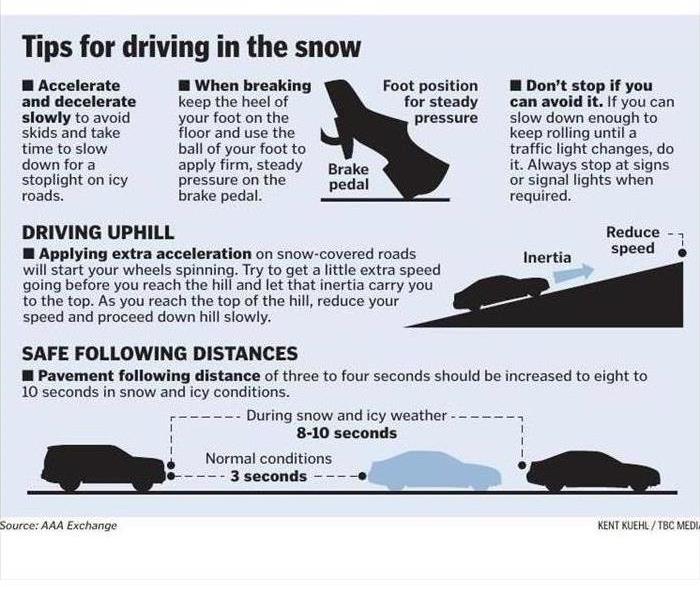 If you and your family plan to hit the road this year, check out Travel Tips from AAA to avoid motor vehicle mishaps. Be safe!
If you and your family plan to hit the road this year, check out Travel Tips from AAA to avoid motor vehicle mishaps. Be safe!
Beware of Fall and Winter Storms!
Fall and winter storms are right around the corner. The effect of these storms can be good or bad. As much as we love the sound of thunder, the jolt of lightning going through the sky and the smell of rain, there are bad things that can come along with it. Power outages are often a risk associated with storms. It’s good to know what to do in case you lose power, because you never know how long it could be out. It could be out for a matter of seconds, or for several hours. Here are some tips on what how to be prepared, and what to do during a power outage.
Keep flashlights available around your house. Avoid using candles when possible.Keep the opening of freezers and refrigerators to a minimum. When kept closed, refrigerators can stay cool up to 4hours, and freezers can stay frozen up to 48 hours. If need be, you can put ice in a cooler to keep your food cold.Watch out for carbon monoxide poisoning. If you are running a generator, it should be used outside and at least 20 feet away from a window or door. Never use a gas stovetop, oven, camp stove, or charcoal grill to heat your home.If it’s cold in your home, add more layers of clothes and blankets. Don’t use the oven or a grill as a heating source. If it becomes too cold, try to make arrangements to go to another location where heat is available.Turn off and disconnect any appliances and electronics. The power may surge or spike when it is restored, and that may cause damage to the items.If a storm occurs, the safety of you and your family is of the utmost importance.
What if your traveling across the country?
Whether you're going down the road this holiday season, or across the country, traveling in fall or winter weather can be a tricky task. AAA provided some simple solutions to avoiding a motor vehicle mishap.
- Accelerate and decelerate slowly
- avoid skids and take time to slow down for a stoplight on icy roads.
- Properly position feet on pedals
- keep the heel of your foot on the floor and use the ball of your foot to apply firm, steady pressure on the brake pedal.
- Don't stop if you can avoid it
- if you can, slow down enough to keep rolling until a traffic light changes. Always stop at stop signs or signal lights when required.
- applying extra acceleration on snow-covered roads can cause your wheels to spin. Try to obtain extra speed before reaching the hill and let inertia carry you to the top. As you reach the top, reduce speed and proceed downhill slowly.
- normal driving conditions suggest a 3-4 second car spacing. When driving in snow or icy conditions increase that to 8-10 seconds. Doing so allows you time to stop and avoid collisions should you need to.
Please be safe, weather can be unpredictable these days and prepared families can enjoy a safe holiday season.
What to expect when your call SERVPRO of West Riverside City?
We Answer the phone ready to help!
Call Today - (951) 351-8033
We understand that when you call us, you may be feeling confused, stressed, and vulnerable. You need an expert to guide you through this crisis. SERVPRO of West Riverside City has the specific water damage training and experience to help you through this tough time. We specialize in water damage restoration—in fact, it's the cornerstone of our business.
What to Expect
When you call, we will ask several questions regarding your water damage emergency. These questions will help us determine what equipment and resources to bring, including how many trained SERVPRO Professionals may be needed.
Our SERVPRO Representative will ask several questions:
Your name and contact informationYour insurance information (if applicable)The street address of the water-damaged home or businessWhen did the flooding or water damage occur?What caused the water damage (if known)?Is there electricity available (on-site)?About SERVPRO of SERVPRO of West Riverside City
SERVPRO of West Riverside City specializes in the cleanup and restoration of residential and commercial property after a fire, smoke or water damage event. Our staff is highly trained in property damage restoration. From initial and ongoing training at SERVPRO corporate training facility to regular IICRC-industry certification, rest assured our staff is equipped with the knowledge to restore your property.
Meet Our Crew
Don't hesitate to contact us, we are here to help!
Rain Season is Coming up for Riverside County, Are You Prepared?
10/19/2020 (Permalink)
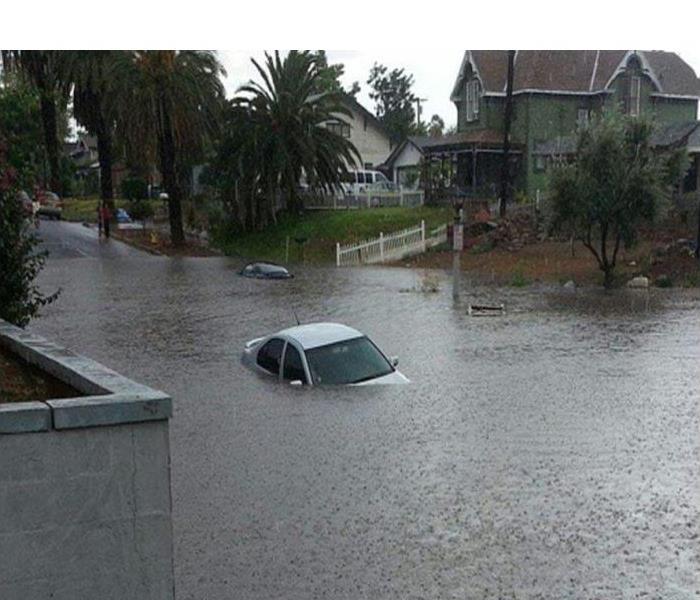 Although we don't get mass amounts of rain to cause this type of flooding in Riverside, we do get flash floods that can cause damage.
Although we don't get mass amounts of rain to cause this type of flooding in Riverside, we do get flash floods that can cause damage.
The chance of wet days in Riverside varies throughout the year. The wetter season lasts 4.2 months, from November 25 to April 1, with a greater than 10% chance of a given day being a wet day.
Though the rain itself usually doesn’t cause structural damage, any water that leaks into a home through gaps in the roof or walls can lead to messes that can be costly to clean up. This water can also lead to damage to walls, ceilings, and floors; as well as mold and mildew problems throughout a home. Also, too much rainwater in a short period of time can overload gutters, causing the rain to fall onto the ground where it can damage the foundation over time. (And of course, rain tends to cause flooding, which has its own problems.)
Clean out roof gutters and downspouts. Clogged gutters allow water to back up onto your roof, increasing the chance of water intrusion into your home or business.Remove loose debris from your yard. Debris, such as fallen tree limbs or unsecured lawn furniture can become dangerous during heavier winds. These items can cause structural damage, such as broken windows, which can lead to water intrusion in your home.Know Your Zone. Determine your flood zoning and prepare appropriately. If you live in a flood prone zone, preparing sandbags may be necessary to help protect your structure.You may be asking yourself when you should replace your roof. Maybe you live or work in an older building, and you know it will become necessary at some point. Perhaps you have seen some water stains in your attic or you have just gone through a season of really heavy weather and some shingles have disappeared. Today we are going to share some things to think about as you decide when you should replace your roof.
Even though it is sunny out and the skies are blue, fall is here along with the rainy season just around the corner. If you have not already been thinking about preparing your home for the rain ahead, now is the perfect time. A simple roof cleaning and maintenance checkup can go a long way to prevent disaster from striking this winter.
A skilled roofing technician can catch things as simple as a loose shingle, or as unexpected as an exterior mortar repair around your chimney. Finding these areas of need now, before the rain exposes the problem and causes more damage, can save you money and potential repairs later down the road.
Think of it this way, do you winterize your boat or RV in preparation for the season? Your roof is no different.
A good seasonal checkup should include the following:
- Broom clean roof surfaces
- Probe all welded seams to ensure proper seam condition (Low slope systems)
- Inspect and renew any caulking, cut edge sealant, etc.
- Access exterior condition of penetrations such as skylights and chimney
- Provide brief photo report to client upon completion of service
- Provide any recommended repairs, if any.
If your home or business experiences a water damage loss, know that SERVPRO of West Riverside City is Here to Help. Our experienced team offers emergency water damage response, 24 hours a day, 7 days a week, allowing us to arrive quickly to begin mitigating the damages.
For more information about our services, call 951-351-8033
National Preparedness Month- Week 2: Build A Kit
9/7/2020 (Permalink)
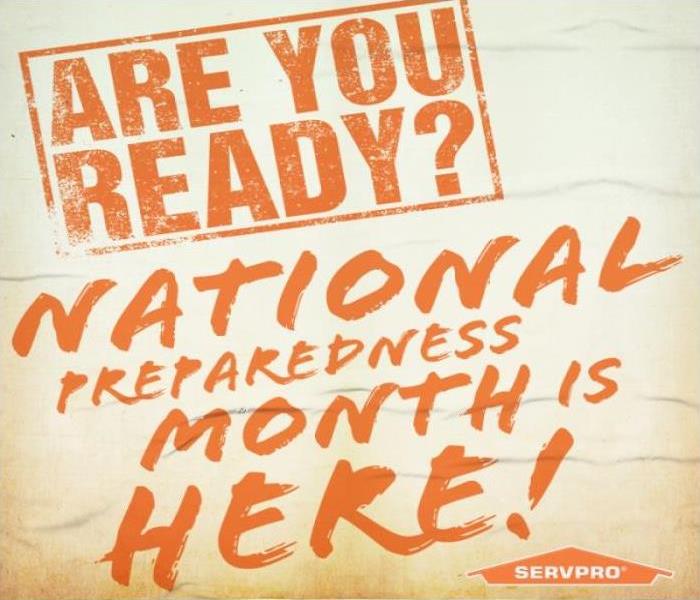 After an emergency, you may need to survive on your own for several days. Are you prepared?
After an emergency, you may need to survive on your own for several days. Are you prepared?
In California, we are affected by wild fires and earthquakes. However, any other natural disaster can hit at any time. Week 2 of National Preparedness Month is building a kit. Do you have the essential items for you and your family should you lose power? Or if all stores are closed?
Gather supplies that will last for several days after a disaster for everyone living in your home. Don’t forget to consider the unique needs each person or pet may have in case you have to evacuate quickly. Update your kits and supplies based on recommendations by the Centers for Disease Control.
Here are some tips on building a kit from Ready.gov:
After an emergency, you may need to survive on your own for several days. Being prepared means having your own food, water and other supplies to last for several days. A disaster supplies kit is a collection of basic items your household may need in the event of an emergency.
Make sure your emergency kit is stocked with the items on the checklist below. Most of the items are inexpensive and easy to find and any one of them could save your life. Headed to the store? Download a printable version to take with you. Once you take a look at the basic items consider what unique needs your family might have, such as supplies for pets or seniors.
Basic Disaster Supplies Kit
To assemble your kit store items in airtight plastic bags and put your entire disaster supplies kit in one or two easy-to-carry containers such as plastic bins or a duffel bag.
A basic emergency supply kit could include the following recommended items:
- Water (one gallon per person per day for at least three days, for drinking and sanitation)
- Food (at least a three-day supply of non-perishable food)
- Battery-powered or hand crank radio and a NOAA Weather Radio with tone alert
- Flashlight
- First aid kit
- Extra batteries
- Whistle (to signal for help)
- Dust mask (to help filter contaminated air)
- Plastic sheeting and duct tape (to shelter in place)
- Moist towelettes, garbage bags and plastic ties (for personal sanitation)
- Wrench or pliers (to turn off utilities)
- Manual can opener (for food)
- Local maps
- Cell phone with chargers and a backup battery
- Download the Recommended Supplies List (PDF)
Additional Emergency Supplies
Since Spring of 2020, the CDC has recommended people include additional items in their kits to help prevent the spread of coronavirus or other viruses and the flu.
Consider adding the following items to your emergency supply kit based on your individual needs:
- Cloth face coverings (for everyone ages 2 and above), soap, hand sanitizer, disinfecting wipes to disinfect surfaces
- Prescription medications
- Non-prescription medications such as pain relievers, anti-diarrhea medication, antacids or laxatives
- Prescription eyeglasses and contact lens solution
- Infant formula, bottles, diapers, wipes and diaper rash cream
- Pet food and extra water for your pet
- Cash or traveler's checks
- Important family documents such as copies of insurance policies, identification and bank account records saved electronically or in a waterproof, portable container
- Sleeping bag or warm blanket for each person
- Complete change of clothing appropriate for your climate and sturdy shoes
- Fire extinguisher
- Matches in a waterproof container
- Feminine supplies and personal hygiene items
- Mess kits, paper cups, plates, paper towels and plastic utensils
- Paper and pencil
- Books, games, puzzles or other activities for children
Maintaining Your Kit
After assembling your kit remember to maintain it so it’s ready when needed:
- Keep canned food in a cool, dry place.
- Store boxed food in tightly closed plastic or metal containers.
- Replace expired items as needed.
- Re-think your needs every year and update your kit as your family’s needs change.
Kit Storage Locations
Since you do not know where you will be when an emergency occurs, prepare supplies for home, work and cars.
- Home: Keep this kit in a designated place and have it ready in case you have to leave your home quickly. Make sure all family members know where the kit is kept.
- Work: Be prepared to shelter at work for at least 24 hours. Your work kit should include food, water and other necessities like medicines, as well as comfortable walking shoes, stored in a “grab and go” case.
- Car: In case you are stranded, keep a kit of emergency supplies in your car.
Whether it's a flood, earthquake, fire, or extreme weather, we must work together as a team to help ensure our family, businesses, places of worship, and neighborhoods are prepared. Contact SERVPRO of West Riverside City to find out how we can help make it “Like it never even happened,” in your life.
SERVPRO of West Riverside City 951-351-8033
We are here to help during those devastating circumstances.
September is National Preparedness Month, Riverside Residents Are You Prepared?
9/2/2020 (Permalink)
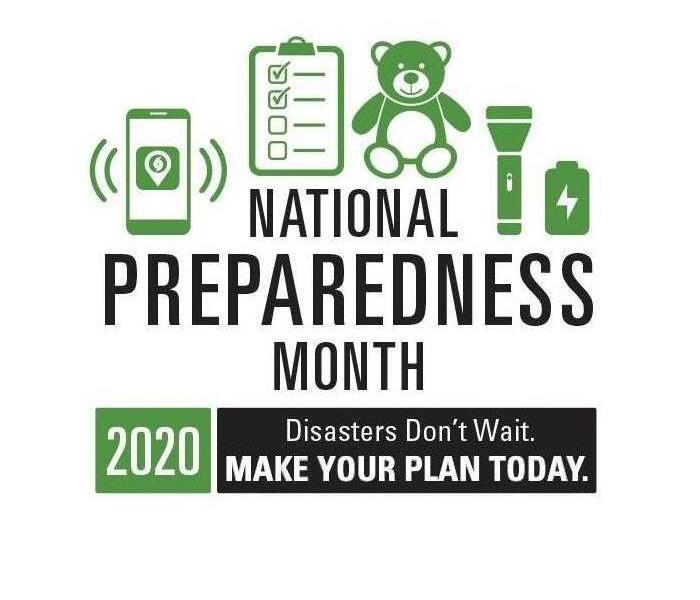 SERVPRO's Emergency Preparedness Plan can help you because, "Disasters Don't Wait. Make Your Plan Today."
SERVPRO's Emergency Preparedness Plan can help you because, "Disasters Don't Wait. Make Your Plan Today."
National Preparedness Month is recognized every September to promote community disaster planning, with the theme for 2020 being “Disasters Don’t Wait. Make Your Plan Today.”
With August behind us, we are still seeing an extremely active fire season we are also faced with extra preparations and precautions due to COVID-19... preparing yourself, your loved ones, and your property for a disaster situation is of the utmost importance. Ready.gov offers weekly National Preparedness Month themes to help organize your preparations:
Week 1 (September 1st-5th): Make a Plan
Determine lines of communication, designated meeting places in case of separation, and responsibilities for each member of your household. Depending on the needs of your family, you may require additional planning steps.
Week 2 (September 6th-12th): Build a Kit
Gather supplies for each member of your family. You kit may include food, clean water, medications, pet foods, communication devices, and batteries. Keep your kit as compact as possible, and in an easily accessible location, in case evacuation becomes necessary.
Week 3 (September 13th-19th): Prepare for Disaster
In the Panhandle of Florida, one of the most common disasters you may face is a hurricane. To prepare for such an event, be sure to follow local and national news as it pertains to hurricane tracking, check your insurance coverage, and make sure your disaster preparedness kit is built. If a storm is forecasted to hit in your area, follow the direction of local officials concerning shelter and evacuation orders.
Week 4 (September 20th-26th): Teach Youth About Preparedness
Make sure children’s needs are included in your preparations. Include their items in your disaster kit, talk with them about protocols and procedures in the event of a disaster situation, and answer any questions they may have.
As a leader in clean up and restoration, SERVPRO of West Riverside is Here to Help in the event your property is damaged by a fire, or sustains damage as a result of an earthquake or any other disaster situation. Serving the inland empire, our team is “Faster to Any Size Disaster!” To learn more about our services, call 951-351-8033.
For more information about National Preparedness Month, visit
https://www.ready.gov/september
Rain Rain Go Away, Beware of Flooding in Riverside!
8/31/2020 (Permalink)
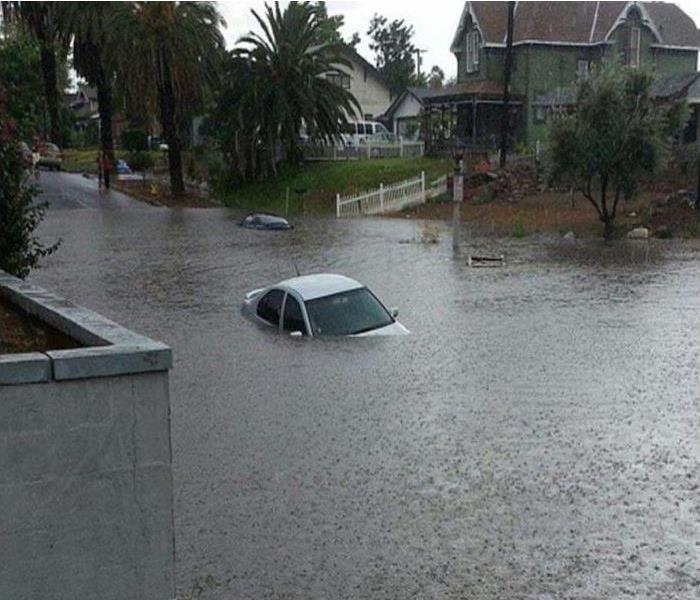 Two feet of rushing water can sweep away most vehicles — including SUVs and pick-ups.
Two feet of rushing water can sweep away most vehicles — including SUVs and pick-ups.
It is important to remember that floods caused by rain can occur anywhere, with floodwaters rising gradually or flash floods striking suddenly. Water's powerful force can easily overtake vehicles and people.
Safety tips for driving in heavy rain:
- If you must drive in the rain, drive slowly and steadily. Pull over and stop if it is raining so hard that you cannot see.
- DO NOT DRIVE THROUGH FLOODWATERS!
- Six inches of water will reach the bottom of most passenger cars, causing loss of control or possible stalling.
- One foot of water will float most vehicles.
- Two feet of rushing water can sweep away most vehicles — including SUVs and pick-ups.
- Stay away from water that electrical or power lines have fallen into; electric current passes through water easily.
- Stay off your cell phone unless you must report severe injuries or call for help.
Safety tips for walking or cycling on urban trails:
- Move to higher ground and never go into a culvert! If you are on a streamside trail during a rainstorm use the alternate trail up to street level to avoid underpasses and culverts.
- NEVER take shelter in a culvert, under a bridge, or in an enclosed space, especially in low elevations . Always go to higher ground out of the flow of water.
- Do not walk or bike through moving water. Six inches of moving water can cause a person to fall.
- If lightning is present, do not stand under or near an isolated tree or group of trees.
- Never allow children to play around drainage ditches or viaducts, storm drains or flooded areas.
Localized street flooding:
- In underpasses and some areas that are geographical low-points, water cannot be expected to disappear down the storm inlets instantly; the pace and volume of the rainfall may be too quick and too great to immediately drain off. It takes time for the system to accommodate the rainfall.
- If you know that your street tends to flood because it is located in a low point, be sure to move your vehicles to higher ground whenever rain is forecast.
Hazards in Your Riverside Home After Flooding
When water enters your home from a structural breach or through natural flooding scenarios, it can be a hazardous situation for your riverside residence. Knowing these risks and what to do about them can be enough to protect those that matter most and help to protect some of your belongings and possessions in the earliest stages of flood losses as well.
Many of the hazards that can exist after flood damage in Riverside homes are universal to any disaster, whether natural flooding or roof/property damage is to blame for the intruding water. Our SERVPRO professionals are often not the first individuals in a damaged home after a flood loss situation, so understanding these hazards before entering the property can keep you safe until our qualified technicians arrive to begin mitigation work.
One of the most pressing concerns for those inspecting the damage to their house is oversaturated materials like ceiling assemblies. Sagging materials are often a strong indication of overweight drywall and insulation that can collapse and injure those underneath it. Wall systems are also at risk for becoming oversaturated beyond the capabilities of drywall screws in studs. These are the areas where our team can perform controlled demolition to help with the drying process and protect other materials nearby.
When standing water reaches outlets near the floor of your home, or electrically charged equipment still powered on, it can cause the pooling water in the area to become electrified. Unless you can be confident that no hazard exists, such as the power getting severed to the structure, do not enter standing water.
Natural flooding presents a real risk of contamination to materials, contents, and occupants. We have disinfection products and cleaning practices that remove these bacterial threats from structural framework remaining installed before full-scale build back begins.
We understand the urgency that you feel when your home gets flooded, but keeping yourself and your family safe should be your priority. Our SERVPRO of West Riverside City team is standing by whenever you need us to help.
National Senior Citizen Day August 21st!
8/18/2020 (Permalink)
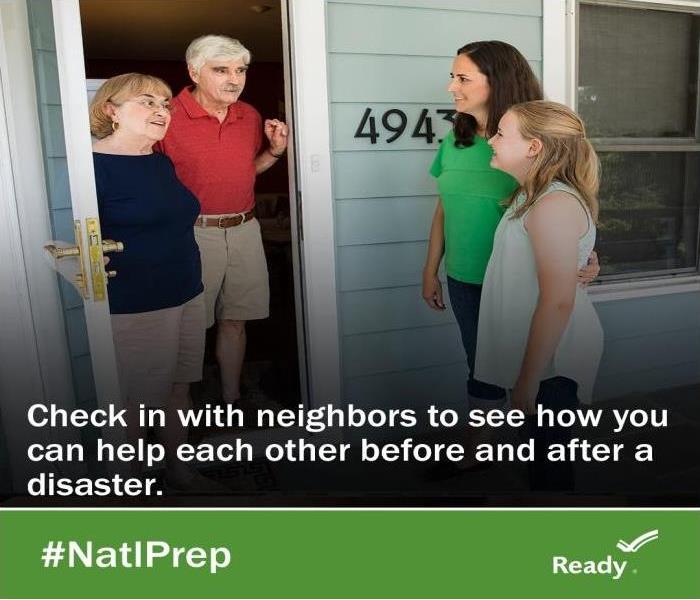 Spend time with the senior citizens you know. Let them know they are appreciated and loved.
Spend time with the senior citizens you know. Let them know they are appreciated and loved.
On August 21st, National Senior Citizens Day recognizes the achievements of the more mature representatives of our nation.
The day provides an opportunity to show our appreciation for their dedication, accomplishments, and services they give throughout their lives.
One way to show we care about our seniors is to ensure they are prepared for an emergency resulting from a storm or natural disaster. Here are 3 ways READY.GOV recommends for our seniors:
- Get a kit.
The first step is to consider how an emergency might affect their individual needs. A plan to make it on their own, for at least three days. It’s possible that they will not have access to a medical facility or even a drugstore. It is crucial that they and their family think about what kinds of resources they use on a daily basis and what they might do if those resources are limited or not available.
Basic Supplies: Think first about the basics for survival – food, water, clean air and any life sustaining items they require. Consider two kits. In one kit put everything they will need to stay where t hey are and make it on their own for a period of time. The other kit should be a lightweight, smaller version they can take with them if they have to leave their home.
Recommended basic emergency supplies include:
- Water, one gallon of water per person per day for at least three days, for drinking and sanitation
- Food, at least a three-day supply of non-perishable food and a can opener if kit contains canned food
- Battery-powered or hand crank radio and a NOAA Weather Radio with tone alert and extra batteries for both
- Flashlight and extra batteries w First aid kit
- Whistle to signal for help
- Dust mask to help filter contaminated air and plastic sheeting and duct tape to shelter-in-place
- Moist towelettes, garbage bags and plastic ties for personal sanitation
- Wrench or pliers to turn off utilities
- Local maps
- Pet food, extra water and supplies for your pet or service animal
- Make a Plan for What they Will Do in an Emergency
For every aspect of their daily routine, plan an alternative procedure. Make a plan and write it down. Keep a copy of their plan in their emergency supply kits and a list of important information and contacts in their wallet. Share their plan with family, friends, care providers and others in their personal support network.
- Create a Personal Support Network
- Develop a Family Communications Plan
- Deciding to Stay or Go
- Consider Your Pets
- Staying Put
- Evacuation
- Fire Safety
- Contact Your Local Emergency Information Management Office
- Be Informed Some of the Things They Can Do
To prepare for the unexpected, such as assembling an emergency supply kit and making an emergency plan are the same regardless of the type of emergency. However, it’s important to stay informed about what might happen and know what types of emergencies are likely to affect their region. For more information about specific types of emergencies, visit www.ready.gov or call 1-800-BE-READY. Be prepared to adapt this information to their personal circumstances and make every effort to follow instructions received from authorities on the scene. With these simple preparations, they can be ready for the unexpected. Prepare For Emergencies Now. Information For Older Americans. www.ready.gov
Their wealth of knowledge, skill, and experience offer so much. They deserve the respect and dignity their achievements earn them. Supporting our senior citizen to live their lives to the fullest and as independently as possible.
HOW TO OBSERVE #SeniorCitizensDay
- Spend time with the senior citizens you know. Let them know they are appreciated and loved.
- Volunteer at a retirement home. Share your smile with those who may not otherwise get a visitor today.
- If you are a senior citizen, check for special discounts and promotions that may be offered at stores and restaurants in your area.
#SeniorCitizensDay
Top 5 things Riverside Residents Need to Have on Hand to Prepare for a Storm
8/13/2020 (Permalink)
Living in Riverside we get the occasional storm that will knock out power for a period of time, especially during high winds.
These 5 thing will come in handy in a time of a storm that cause power loss.
- Canned goods and a manual can opener
Now everyone knows in a natural disaster that canned fruits, vegetables and even things like canned beans are a great food supply. They will last a long time and offer you the nutrients you need.
However, opening a can without a can opener can be difficult and sometimes not possible. Make sure to add a can opener to your set so in a time of disaster you have access to canned goods.
Here are some additional items to have :
- Crackers
- Trail mix and other nuts (for those without allergies)
- Protein/Breakfast Bars
- Canned tuna, salmon, etc.
- Canned Soup
- Dried Fruit
- Ensure/ Non-refrigerated individual cartons of organic milk
- Batteries (big and small)
One of the most important things you’re going to need in the event of a storm is power and if you don’t have a generator, you’re going to be relying on batteries to get you through the day.
Not only are they going to be powering the flashlights you’re using to see at night, but they’re going to be powering other things as well that you’ll have to remember. For example, don’t forget to stock up on your hearing aid batteries if that’s one of the things you use.
The most important thing, and everybody pretty much knows this, is you want to have drinking water on hand but what everybody doesn’t really know is how much do you need?
The American Red Cross recommends that you have one gallon, per person, per day in the event of a natural disaster. So that means a family of four, over five days is going to need 20 gallons of water.
Your water could be out longer than 3 days, or fresh water could become You can also buy water purification tablets or a filtering system at a camping store or online.
When the power is out, credit cards and ATMs are a no-go so cash is a must have. Always keep a handy amount ready to go in case the storm fallout lasts longer than you anticipated and you need to get more supplies or fill up your gas tank.
If your home or business ends up sustaining damage from inclement weather, call SERVPRO of West Riverside City as soon as possible - we can help you get your property restored to preloss condition. Don’t wait to mitigate - call us as soon as you see storm damage on your property: 951-351-8033.
Everything That Storm Damage Cleanup Entails for your Riverside Home
4/20/2020 (Permalink)
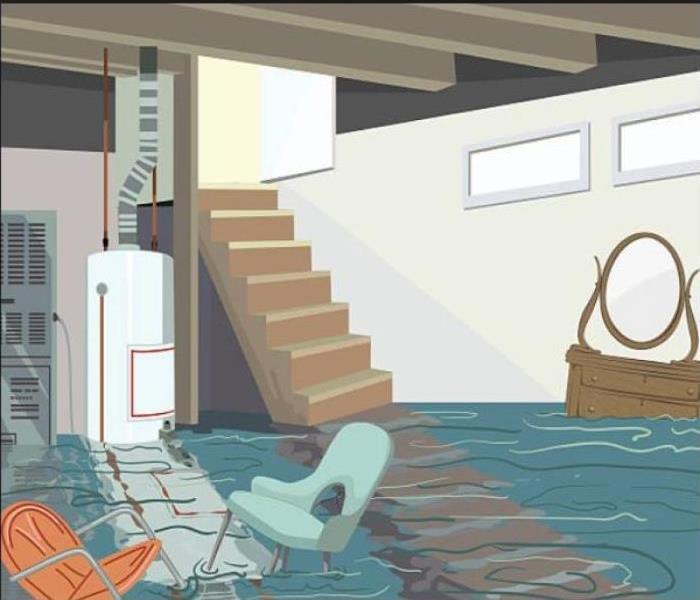 If your Riverside home has faced water damage from a storm, we are here to help. Give us a call and we can provide free inspection.
If your Riverside home has faced water damage from a storm, we are here to help. Give us a call and we can provide free inspection.
After your Riverside neighborhood has been hit by inclement weather, now, to call SERVPRO of West Riverside City professionals to make everything look like new again.
However, do you really understand the steps that will take place? Here’s a quick breakdown of everything that a storm damage cleanup job may entail, from start to finish.
1) An Inspection of the Damage
The first thing that the storm damage cleanup professional at SERVPRO of West Riverside City will do is complete an assessment of damage. They’ll walk through your house and make a note of everything that the storm had affected. Any puddles of water, soaked carpeting, holes in the walls, and more will be thoroughly documented and photographed. The storm damage cleanup team at SERVPRO of West Riverside City will provide you with a punch list of everything that needs to be done. We will also work with your home insurance company to help mitigate the situation. This assessment will contain costs, scope of work description and a timeline.
2) Removing Any Existing Water
After the storm damage cleanup company has received written permission to begin the restoration process Riverside, they will remove all content from the affected area and start the extraction of water that’s in your home. They’ll use special equipment soak up puddles that a simple set of towels cannot handle and ensure that every bit of standing water in your home is removed. They will go through every step necessary to complete this task, including blotting your carpeting and taking care of any sodden curtains. Know that any content damaged Riverside can also be service by SERVPRO.
3) Running a Dehumidifier and Drying Everything Out
Next, the storm damage cleanup crew will set up dehumidifiers for the drying process. They are necessary. The lack of puddles of standing water doesn’t mean that the job is over. Your floorboards, walls, carpeting, ceilings and everything else that received water damage could still be moist. That dampness, when left alone, will lead to mold. It’s SERVPRO of West Riverside City's duty to make sure that this mold doesn’t have a chance to set in, so they’ll go through the additional steps to completely dry every surface.
4) Sanitizing the Space
Once everything is dry, our team will start cleaning and sanitizing. This ensures that things like mold won’t be able to set up shop, so to speak. The storm damage cleanup crew will SERVPRO patented cleaning solutions to kill off any potential germs or irritants lurking in your formerly waterlogged home. This can only be done once all of the water has been removed, and those carpets and walls are now dry.
5) Performing Restoration Services
Finally, the last of the restoration services are completed. This consists of the storm damage cleanup crew going through and repairing holes in the walls and ceiling, replacing broken windows, and even repainting walls, if necessary. They will do everything required in order to make your home look just like it did before the storm – only cleaner. In addition, the best companies take the time to ensure that you’re pleased with the results.
Call SERVPRO of West Riverside City today, if your home has experienced any water damage – large or small! 951-351-8033
How to Prevent Wind Damage to Your Riverside Property
3/23/2020 (Permalink)
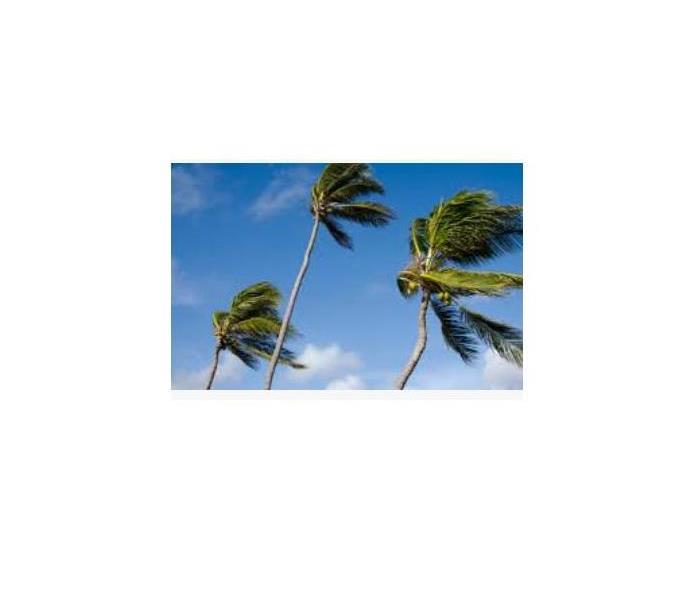 Riverside is known for strong winds, don't hesitate to contact SERVPRO of West Riverside City. We offer free inspections!
Riverside is known for strong winds, don't hesitate to contact SERVPRO of West Riverside City. We offer free inspections!
There are many areas of the United States that have experienced heavy winds and storms this season and the strong powerful winds can cause significant damage to your home. Wind damage can cause a range of destruction to your property from broken windows and fallen tree branches to more severe damage to the roof, garage, or car. It can happen to your home directly from the strong wind or indirectly from the wind blowing debris into your house.
Wind Damage from Different Types of Storms
Thunderstorms are the most common source of wind and storm damage but winds from hurricanes or tornadoes are stronger and can cause more severe damage. It can produce many types of damaging weather such as lightning, hail, tornadoes, straight-line winds, flooding and more. Thunderstorms are responsible for over half of all wind damage cases in the U.S. but the storm damage repair may be more costly for hurricane or tornado wind damage. Billions of dollars are spent on wind damage repair and storm damage restoration each year; understanding the nature of wind damage can help you limit the amount of damage to your property and save on restoration and repair costs.
It is important to know when a storm is approaching your area and what type of storm it is so you know the potential and level of damage to expect. These wind damage facts will help you better understand the potential for wind damage and how to prevent it. Here are some steps you can take to minimize the risk of damage to your home when severe weather strikes.
Preventing Wind and Storm Damage
Most wind damage is caused by flying debris either from plants or other structures and objects that are not secured. If a storm is approaching your area, make sure any potential debris around your home such as patio furniture, toys, garbage cans, and other objects are either secured or brought inside. Your doors and windows should also be secured to help minimize the potential storm damage to the home.
Roof damage can be reduced during the construction phase when the roof deck and the shingles or membrane is applied over the decking. A well-designed roofing system will firmly anchor the trusses and decking to the walls and foundation to keep the entire roof from lifting off the building in a strong wind. Roofing material must be properly fastened to the deck. Weakly connected shingles will lift easily from the deck.
Siding damage can be reduced at the construction phase as well. Properly fastened siding is less likely to lift off a structure in strong wind. Building codes will likely direct the minimum standards for connections. You, your architect, or your contractor may decide to exceed these minimums for a stronger and more storm resistant structure.
Falling trees and tree limbs are another significant type of damage to structures in a windstorm. Tree maintenance to remove dead limbs or identify and remove weakened trees will reduce the likelihood of the structure being damaged.
Mitigating Damage after a Storm
Close any openings made in the structure by the wind. Roof openings and broken windows are the most common problem. Keep a roll of plastic sheeting that can be quickly cut to size and nailed over the opening.
Keep your personal safety in mind and attempt such a closure yourself only if it can be done with little or no risk. Your insurance policy will likely cover the cost of emergency close up. Contact your agent or claims center to report the damage and seek advice on how to proceed.
Falling trees and tree limbs can open a structure with sudden violence. A tree on a structure is a very serious personal and structural safety issue. A tree may look as if it will not shift position. But it can shift and cause serious injury to the unwary. A fallen tree may also mask other very serious safety issues, such as downed electrical wires. The wires may still be live and the tree itself energized. Contact your agent or claims center to report the damage and seek advice on how to proceed.
If your home or business sustains wind damage during a storm, it is important to contact a storm damage restoration professional as soon as the storm is over to help limit and repair the damage. SERVPRO of West Riverside City can respond immediately to storm and flooding conditions. Our quick response will help prevent secondary damage and help reduce restoration costs.
Visit our website for more information regarding our services and why it is important to select a qualified services to assist with your damaged property. It is for your safety and that of your family. We make it our goal to help our neighbors!
Have Storm or Flood Damage?
Call Us Today (951) 351-8033
10 Crucial Things To Know Before You Start Driving In The Rain
1/15/2020 (Permalink)
 In Riverside County we experience flash floods frequently, this information is vital in keeping ourselves and passengers safe.
In Riverside County we experience flash floods frequently, this information is vital in keeping ourselves and passengers safe.
In Riverside County we experience flash floods frequently, this information is vital in keeping ourselves and passengers safe.
Driving in rain, whether a sprinkle or a heavy downpour, can be one of the most difficult driving situations a driver encounters. Rainy conditions are directly associated with higher accident rates. No matter what part of the country you live in, it is almost certain that you will be required to drive your vehicle in the rain at some point. Knowing how wet roads and reduced visibility affects the way your vehicle handles will help you drive safely in rainy conditions.
Nearly half (46%) of all weather-related car accidents — more than 700,000 a year — are due to rain.1 As we may experience more soggy weather, it's imperative that all drivers are schooled on how they can safely maneuver their vehicle and avoid weather-related auto accidents, which often cause car insurance rates to rise- Mercury Insurance
Here are 10 tips for driving in the rain:
Step 1. Exercise caution. Engine oil and grease build-up on roads and highways over time, and when combined with precipitation, you’ve got the equivalent of an automotive Slip ‘N Slide.
Step 2. Slow down. Wet pavement causes tires to lose traction and vehicles become more difficult to handle.
Step 3. Use headlights. Always use headlights in the rain – even if it’s just a sprinkle. Headlights help you see and be seen in wet weather.
Step 4. Keep your windshield wipers in tip-top shape. Summer can wreak havoc on your blades, so get them checked before fall’s showers arrive.
Step 5. Defog your windows. Precipitation can cause your windshield to quickly fog up, so use the front and rear defrosters to maximize visibility.
Step 6. Avoid pooling water. By splashing through puddles you can impair your vision and other drivers’. Additionally, standing water often shields potholes and debris from view and it can reduce the effectiveness of your vehicle’s brakes.
Step 7. If your car begins to hydroplane, do not brake or turn the wheel abruptly as this may cause your vehicle to go into a skid or spin. Take your foot off the gas and keep the wheel straight until your car reclaims traction.
Step 8. Increase your following distance. Slick roads, wet brakes and reduced visibility can lead to collisions. Give other vehicles plenty of room and brake early with reduced force.
Step 9. Don’t use cruise control. It can cause your car to accelerate when hydroplaning and reduces driver attentiveness.
Step 10. Drive in the tracks of the car in front of you. This allows the vehicle ahead to displace any standing water that’s on the road.
By employing these safe driving techniques you can keep yourself and your passengers safe during fall and winter drizzles and downpours. Rainy roads can be dangerous, but if we all slow down and use extra caution, rainy days might actually be a little brighter.
8 Signs that Can Predict a Falling Tree in Riverside City
12/18/2019 (Permalink)
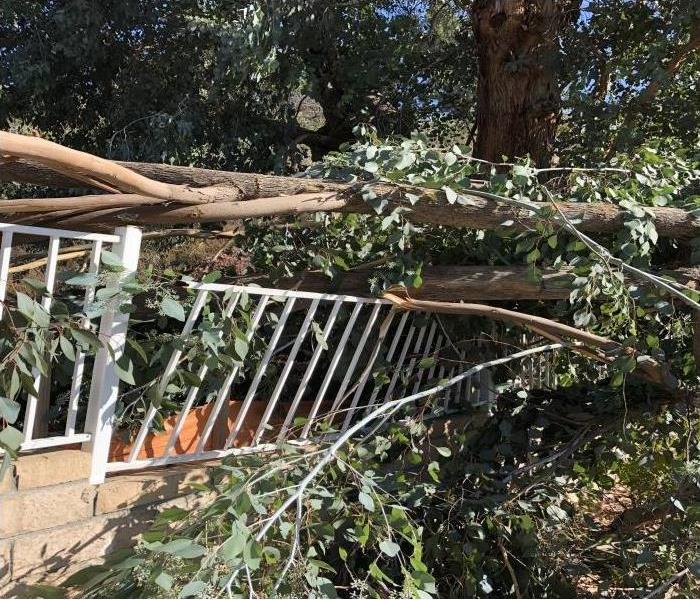 This oversized tree branch broke off the main tree trunk due to not being maintained.
This oversized tree branch broke off the main tree trunk due to not being maintained.
Trees can be the perfect accent to the appearance of your home or property. However, they are also one of the most common sources of roof damage, especially during storms. With storm season among us in Central Florida it is important that homeowners and property managers alike are able to recognize some of the signs of trees that are more likely to fall.
1. Leaning to One Side
A slight lean of your tree should not be a huge concern since most trees do not grow perfectly straight. However, be wary of trees that lean uncomfortably in one direction, especially if in the direction of your roof. Leaning trees that are very close to the point of falling sometimes have exposed roots near the base and cracked soil on the opposite side of the lean. In some cases, the cause of the lean can be a weight distribution issue that can be balanced by pruning branches.
2. Multiple Trunks
If you have a tree with U-shaped multiple trunks, be sure to inspect for deep cracks and other signs of weakness. Mature trees are most at risk for splitting down the middle during heavy rains and stormy weather. To prevent the tree’s splitting, consider hiring a certified arborist who can attach cables between trunks and braces to strengthen their bonds.
The best offense is a good defense when it comes to protecting your roof from falling trees. Take the time to inspect trees on your property and mark ones that match some of the above warning signs. Don’t be afraid to remove unstable trees, though you should call an arborist before attempting to fell the tree yourself.
3. A Hole in the Trunk
A cavity can form in the trunk of a tree when the tree prunes itself by dropping a branch. That can lead to decay inside the tree. This doesn’t always mean danger, though, according to the United States Department of Agriculture Forest Service. If there’s enough sound wood around the cavity, the tree probably won’t fall.
4. Missing Bark or Deep Cracks
An area where tree bark is missing, gashed or indented is called a “canker”. A canker can make a tree more likely to break at that spot, even if the wood looks OK, according to the International Association of Certified Home Inspectors (InterNACHI). Deep cracks in the bark are a bad sign, too.
5. Dead or Falling Branches
When trees start dropping bits of branches or entire branches, it’s a clue that something’s wrong. The tree tries to make itself smaller so there is not as much to feed. Dead branches are a major danger and can come crashing down even on a calm day, according to the USDA Forest Service
6. Losing Leaves from the Outside In
When a tree loses leaves in this pattern often it means something is wrong with the root zone. The root zone is where the tree gets nutrients and water — and it’s what holds the tree up. Without a healthy root system, a tree can fall more easily.
7. Rotten Roots
Root rot can be hard to spot. Look for mushrooms growing around the base of a tree. Fungi growing on the trunk can be another clue that the tree is rotting inside.
8. Tight Branch Growth
When branches grow close together in a V-shape, it’s a bad sign. A strong union will be U-shaped. Elm, maple, oak, yellow poplar and willow trees tend to break at weak forks. When the wind blows, these trees can fall apart. This problem is easiest to spot in winter after the leaves have fallen off.
Risks After Roof Damage From Fallen Trees
The roof is a protector of your home. So, make sure your trees are ready to withstand the stormy weather. A damaged roof may make it easier for your property’s interior to sustain additional damage from water and in many cases mold growth. If you have sustained roof damage, make sure to call a professional roofer to repair the damage. Also, should the roof be damaged during a storm, SERVPRO of west Riverside City is available 24/7 at 951-351-8033 to extract water and dry your property to prevent further damage.
Roof Tarps: Preventing Further Storm Damage to Your Riverside Home
12/5/2019 (Permalink)
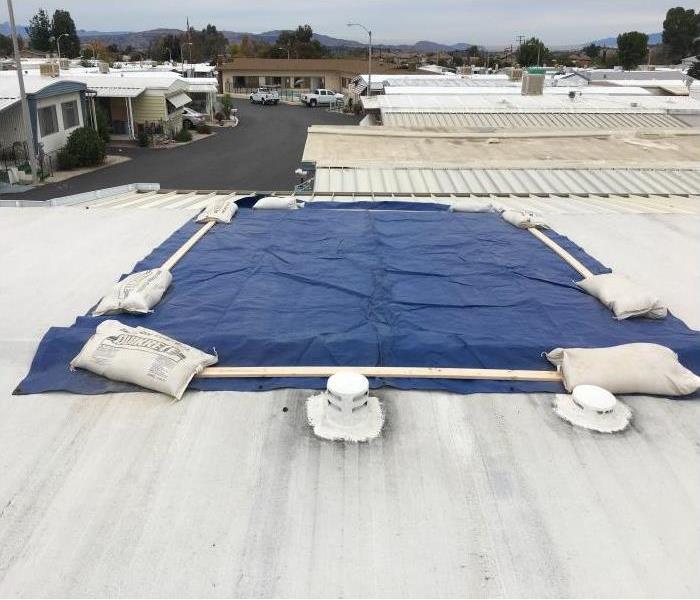 This Yucaipa home experienced water leaking in the living room from the rain. We used a tarp to prevent further damage with upcoming rain.
This Yucaipa home experienced water leaking in the living room from the rain. We used a tarp to prevent further damage with upcoming rain.
With the crazy winds and weather we have been experiencing, it is possible your home or business may be damaged by the elements. Roof damage can be caused by heavy rains, winds or falling debris.
To reduce the possibility of even more damage, some may use a roof tarp, offering a quick solution and a gap of time until better weather permits a safe inspection and repair.
It seems like a good, and cheap, way to quickly cover the holes in the roof, stop the water leak, and prevent rodents from entering the home or business through those holes, although we do not recommend this as a permanent solution to the problem.
It will wear out over time.It is only a temporary fix, and can cause more problems as time passes.If the roof has water damage, mold could be growing in the affected areas.Wind can move the tarp, leaving spaces uncovered and the roof will leak again.If not installed properly, it could hold pools of standing water, aka, mosquitoes.The tarp can increase the heat inside your home or business. Heat and moisture trapped under the tarp may cause mold and other damage inside your property.Before you climb up to fix a tarp yourself, consider the following safety information:
Never get onto your roof during a lightning storm.Steep roofing surfaces require specialized harness systems.Falls from the roof account for 30 percent of construction accidents and up to 75 percent of fatalities.Did you know SERVPRO of West Riverside City can help you with your damaged roof? SERVPRO of West Riverside City does more than just fire, water and mold restoration and clean-up. Our crew is well trained for storms; including installing a tarp on your roof! Our team has been trained on how to safely tarp a roof.
The first step technicians take is inspecting the extent of the damage. You may also want to take photographs of the wind damage to the roof. The records from the technicians and your camera should be shared with the insurance company as evidence for y our claim. If possible, provide some pictures of the condition of your home before the storm.
Removing Storm Debris
If there are tree branches or other storm debris on top of your home, storm restoration technicians clean up the mess. They may also trim up any trees or bushes that pose further risk.
Setting Up Tarps To Cover Holes
Technicians work quickly to cover roof damage, such as holes, with tarps, plywood, and hardware. They'll lay out the tarp to provide a wide barrier that keeps moisture out of cracks and holes. The plywood is often used to secure the tarp, so further wind damage can be avoided.
Preparing a Restoration Plan
Once further storm damage is prevented, technicians create a plan for repairing the damage to your roof. In addition to carrying out the necessary permanent repairs, the home remediation experts may help you prepare a plan for preventing future wind damage.
Prepare Today
Many Riverside, homeowners are concerned when heavy storms hit their neighborhoods. You don't have to worry when you have taken steps to prevent roof damage. Don't wait until a storm hits to get professional advice on preparing your roof. Find the information you need and ease your concerns today.
If your home or business' roof gets damaged during a storm give our office a call 951-351-8033. We are available 24/7 for calls and services. We will have a technician sent out to save the day as quickly as possible to your location!
We service all of Inland Empire and surrounding counties. Call us, we're here to help!!
Storm Chasing Companies, Should Riverside Residents Trust Them?
11/13/2019 (Permalink)
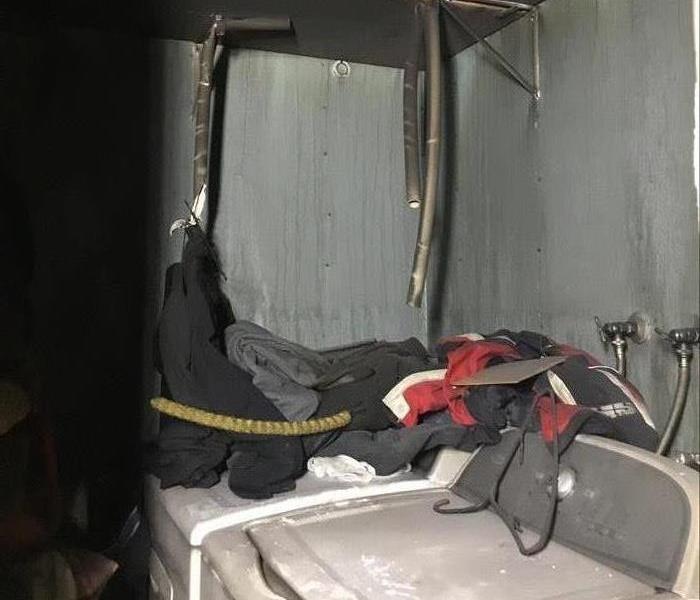 This home caught fire in Riverside, be prepared with phone numbers. Inform your insurance agent & Call SERVPRO of West Riverside City 951-351-8033
This home caught fire in Riverside, be prepared with phone numbers. Inform your insurance agent & Call SERVPRO of West Riverside City 951-351-8033
Don't be scammed by storm chasers.
Contractor duo trolled neighborhoods after storms, offering to fix damaged homes. The duo stole more than $770,000 in down payments from storm-traumatized homeowners — without fixing the homes. Many victims were elderly. These storm chasers have a new roof: They received up to 20 years in prison. This story ended in justice but all too often home and business owners are taken advantage of by less than reputable people.
You can keep scammers away. Protect your family, bank account and yourself from crooks: Stay alert, ask questions and go slow and pay attention to details.
Contact your insurance agent don’t trust that the contractor will file the claim for you. No one should be filing a claim on your insurance but you. This is a good time to talk with your agent about if you should even file a claim or not. You may need additional information like estimates from a reputable company.
After a damage to your car or home...Take photos of the damage and passengers. You can prevent fake injury and damage claims.
Contact your state insurance department or National Insurance Crime Bureau (1-800-835-6422) to report a scam. You can also report a scam with the BBB
Check with your insurance company about policy coverage and specific filing requirements. Save all receipts, if temporary roofing repairs are necessary. Know what your deductible is and know when to file a claim.
Although you may be anxious to get things back to normal, avoid letting your emotions get the better of you. Don't be pressured into making an immediate decision with a long-term impact. Be proactive in selecting a business and not reactive to sales solicitations. It is common for storm chasers to call and knock on your door.
For major repairs, take time to shop around and get 3-4 estimates based on the same specifications and materials. Check out references that are at least one year old, verify with your local government to find out whether or not businesses are required to be licensed/registered to do work in your area, and check with your local building inspector to see if a building permit is required.
Be wary of door-to-door workers who claim to have leftover materials from a job “down the street” or who do not have a permanent place of business. If salespeople go door-to-door, check to see if your community requires them to have solicitation permits.
Be leery if a worker shows up on your doorstep to announce that your home is unsafe. If you are concerned about possible structural damage in your home, have an engineer, architect or building official inspect it. While most roofing contractors abide by the law, be careful allowing someone you do not know inspect your roof. An unethical contractor may actually create damage to get work. This goes for Mold Remediation also. Contact an independent environmental specialist to perform an air quality test. Or ask if they do the test themselves or do they have a third party perform the test. If the mold inspection company does the testing or the roofer does the inspection what do you think the odds of them finding work for themselves to perform are?
Require a written contract agreement with anyone you hire. Be sure their name, address, license number, if applicable, and phone number are included in the contract. Read and understand the contract in its entirety, and don’t sign a blank contract. A copy of the signed contract is to be given to you at time of signature. What certifications does the company have?
Storm damages change based on your location. We here in the California area experience wildfires and strong winds. But in other areas they experience tornadoes or hurricanes. It's still important to be informed on the various kinds of storms that could occur in your area. Be prepared on who to contact. Have numbers handy on your phone. Inform your insurance agent and Call a trusted company, call SERVPRO of West Riverside City 951-351-8033
National Preparedness Month -Week 2: Make a Plan to Prepare for Disasters Sept 8-14
9/9/2019 (Permalink)
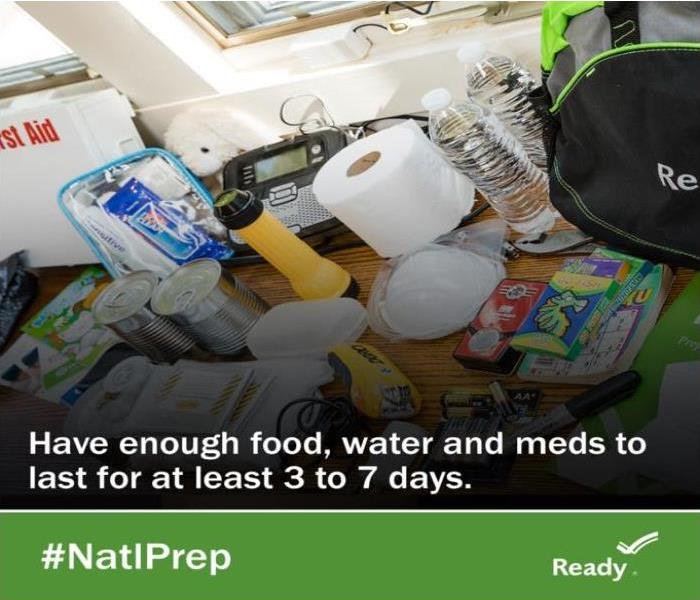 An emergency food storage of canned and nonperishable items, as well as bottled drinking water are essential. Plan ahead!
An emergency food storage of canned and nonperishable items, as well as bottled drinking water are essential. Plan ahead!
The only certain thing about disasters is that nothing is certain about disasters.
Natural or manmade, a disaster can happen at any time, and your family may not be together when they strike. Having a plan in place can help your family reconnect with one another and maximize their safety. But you have to plan to make a plan, and Ready.gov has the steps that you need to do this.
Step 1: Answer these questions
- How will we receive emergency alerts and warnings?
- What is our shelter plan?
- What is our evacuation route?
- What is our family communication plan?
The discussions that these questions will lead to can build the foundation of your family’s disaster strategy. What emergency alerts are available?
Wireless Emergency Alerts (WEA) are alerts sent at the right time to help keep you safe during an emergency. With WEA, warnings can be sent to your mobile device when you may be in harm's way, without the need to download an app or subscribe to a service. These messages are sent by authorized government alerting authorities through your mobile carrier. What types of alerts will you receive?
- Extreme weather, and other threatening emergencies in your area
- AMBER Alerts
- Presidential Alerts during a national emergency
Emergency Alert System (EAS) EAS is a national public warning system that requires broadcasters, satellite digital audio service and direct broadcast satellite providers, cable television systems, and wireless cable systems to provide the President with a communications capability to address the American people within 10 minutes during a national emergency.
EAS may also be used by state and local authorities, in cooperation with the broadcast community, to deliver important emergency information, such as weather information, imminent threats, AMBER alerts, and local incident information targeted to specific areas.
NOAA Weather Radio is an automated 24-hour network of VHF FM weather radio stations in the United States that broadcast weather information directly from a nearby National Weather Service office. NWR broadcasts official warnings, watches, forecasts and other hazard information 24 hours a day, 7 days a week. It also broadcasts alerts of non-weather emergencies such as national security, natural, environmental, and public safety through the Emergency Alert System.
Step 2: Know the needs of your household
Your family’s daily living needs can dictate parts of your plan. Do you have pets or service animals? Do any family members require special medication or medical equipment? Etc.
- Different ages of members within your household
- Responsibilities for assisting others
- Locations frequented
- Dietary needs
- Medical needs including prescriptions and equipment
- Disabilities or access and functional needs including devices and equipment
- Languages spoken
- Cultural and religious considerations
- Pets or service animals
- Households with school-aged children
Developing an easy-to-remember plan is also important. After all, an emergency plan is not effective if it isn't remembered. This is especially true for families with older adults or children to consider. Keep your emergency plan as simple as possible and use places that are very familiar and hard to forget.
Preparing for extended periods of emergency is also important. Natural disasters may knock out power, pollute drinking water, and make it difficult for first responders to reach you. Best prepare to be in it for the long haul. An emergency food storage of canned and nonperishable items, as well as bottled drinking water are essential, especially for families living in areas with an increased likelihood of natural disasters, including hurricanes, tornadoes, earthquakes, wildfires, and snow emergencies.
Step 3: Fill out a Family Emergency Plan and Practice
You have worked hard with your family to create a plan, but it is paramount to have the plan written down and that all of the family members are comfortable with it. There are examples of Family Emergency Plans on Ready.gov website. And make sure to schedule family practices regularly, this will make sure that every member of the family knows the plan or you can find and overcome obstacles that may cause problems.
Naturally, disasters will be stressful and difficult to endure. However, planning ahead of time will help you stay calmer and allow you to think and act properly during any catastrophe.
You may not be able to keep disasters from happening, but you can control how you prepare for them. Get that family meeting scheduled today.
SERVPRO of West Riverside City is here for your emergency needs when it comes to fire, water, or smoke damage due to a natural disaster. We are available 24 hours a day, 7 days a week. Add our contact information to your emergency list. We are faster to any disaster. You can expect an immediate response time, day or night.
Call us at 951-351-8033 or visit our website SERVPRO storm-flooding-restoration we are here to help.
National Preparedness Month- Week 1: Save Early for Disaster Costs Sept 1-7
9/4/2019 (Permalink)
Natural disasters, which occur across all parts of the United States, result in severe damage to natural and built environments, have long-term economic impacts and often lead to loss of life.
In 2017, more than 25 million Americans were affected by natural disasters, most notably hurricanes in the southeast, and wildfires in the west. It was also the most expensive year on record for natural disasters, with $306.2 billion in damage and 362 deaths.
From NCSL.Org
Ready.gov has joined FEMA during National Preparedness Month to provide strategies to help us prepare for and bounce back from unexpected events.
Americans at all income levels have experienced the challenges of rebuilding their lives after a disaster or other emergency. In these stressful circumstances, having access to personal financial, insurance, medical, and other records is crucial for starting the process of recovery quickly and efficiently. Taking the time now to collect and secure these critical records will give you peace of mind and, in the event of an emergency, will ensure that you have the documentation needed to start the recovery process without delay.
- Gather financial and critical personal, household, and medical information.
- Consider saving money in an emergency savings account that could be used in any crisis. Keep a small amount of cash at home in a safe place. It is important to have small bills on hand because ATM’s and credit cards may not work during a disaster when you need to purchase necessary supplies, fuel or food.
- Obtain property (homeowners or renters), health, and life insurance if you do not have them. Review existing policies for the amount and extent of coverage to ensure that what you have in place is what is required for you and your family for all possible hazards. Homeowners insurance does not typically cover flooding, so you may need to purchase flood insurance from the National Flood Insurance Program.
- Scroll down for more helpful financial preparedness tips and download the Emergency Financial First Aid Kit (EFFAK) to get started planning today.
For Organizations
Encourage people throughout your organization to be financially prepared. Here are some ideas to promote financial preparedness in your organization:
- Hold a brown bag meeting or
- Make a presentation at an existing staff meeting using the Emergency Preparedness Financial First Aid Kit PowerPoint and use the Safeguarding Your Valuables Facilitator Guide to support your discussion.
- Include financial preparedness information in the staff monthly newsletter.
At Home
Using the EFFAK as a guide, or by downloading a secure mobile app on your phone, store important documents either in a safety deposit box, an external drive, on the cloud to make it easy to access during a disaster.
Having your financial and medical records and important contact information will be crucial to help you start the recovery process quickly. Take time now to safeguard these critical documents.
Household Identification
- Photo ID to prove identity of household members
- Birth certificate to maintain or re-establish contact with family members
- Social security card to apply for FEMA disaster assistance
- Military service
- Pet ID tags
Financial and Legal Documentation
- Housing Payments to identify financial records and obligations
- Insurance policies to re-establish financial accounts
- Sources of income to maintain payments and credit
- Tax statements to provide contact information for financial and legal providers & apply for FEMA disaster assistance
Medical Information
- Physician information to provide doctors with health information if medical care is needed
- Copies of health insurance information to ensure existing care continues uninterrupted
- Immunization records
- Medications
Insurance Information
Having insurance for your home or business property is the best way to ensure you will have the necessary financial resources to help you repair, rebuild, or replace whatever is damaged. Document and insure your property now.
Household Contact information
- Banking Institutions
- Insurance agent
- Health professionals
- Service providers
- Place of worship
Get your benefits electronically
A disaster can disrupt mail service for days or weeks. If you depend on Social Security or other regular benefits, switching to electronic payments is a simple, significant way to protect yourself financially before disaster strikes. It also eliminates the risk of stolen checks. The U.S. Department of the Treasury recommends two safer ways to get federal benefits:
- Direct deposit to a checking or savings account. Federal benefit recipients can sign up by calling (800) 333-1795 or sign up online
- The Direct Express® prepaid debit card is designed as a safe and easy alternative to paper
From ready.gov/financial-preparedness
SERVPRO of West Riverside City encourages our neighbors to take steps to be financially prepared should a major earthquake, wildfire, flooding or other natural disaster occur in our area. Add our contact information to your emergency list. We can help ease the stress should you face a loss due to a disaster. We can make it "Like it never even happened."
June is National Pet Preparedness Month
6/17/2019 (Permalink)
 June is National Pet Preparedness Month
June is National Pet Preparedness Month
A little preparation goes a long way in an emergency and having a "go bag" will help you keep calm and evacuate quickly.
This is especially important if you have the added responsibility of pets. Emergencies come in many forms, and they may require anything from a brief absence from your home to permanent evacuation. Each type of disaster requires different measures to keep your pets safe, so the best thing you can do for yourself and your pets is to be prepared.
If you already have a "go bag" or evacuation pack, use this month as an annual reminder to replace old food and medication and to update photos and emergency contact information.
If you haven't created a bag, use this list to help get you started:
- 7 days worth of food (rotate regularly and if you use canned food, buy cans with a pop-top)
- 7 days of bottled water (rotate regularly)
- Medication (rotate regularly)
- Food/water bowls
- Extra collar, harness, and leash
- Clean up supplies (pet cleaning solution and paper towels)
- Plastic bags (to serve double duty as garbage and poop bags)
- Flashlight
- Blanket
- Toys and chews
- Carrier
- Copies of medical records
- Contact information for local veterinarians, pet friendly hotels and shelters, and out-of-town family members willing to take in your pets
- Recent photo for making lost posters
- First aid kit with pet-specific supplies
For more information on preparing your canine family for natural disasters, visit the ASPCA web site.
Some things to Keep in Mind
- Locate a veterinarian or animal hospital in the area where you may be seeking temporary shelter, in case your pet needs medical care. Add the contact information to your emergency kit.
- If you are unable to return to your home right away, you may need to board your pet. Find out where pet boarding facilities are located.
- Call your local emergency management office, animal shelter or animal control office to get advice and information.
- Most boarding kennels, veterinarians and animal shelters will need your pet's medical records to make sure all vaccinations are current.
- Create a buddy system in case you’re not home. Ask a trusted neighbor to check on your animals.
- Make sure all pets wear collars and tags with up-to-date identification information. Your pet’s ID tag should contain his name, telephone number and any urgent medical needs. Be sure to also write your pet’s name, your name and contact information on your pet’s carrier.
- The ASPCA recommends micro-chipping your pet as a more permanent form of identification. A microchip is implanted under the skin in the animal’s shoulder area, and can be read by a scanner at most animal shelters.
- Get a Rescue Alert Sticker from ASPCA-This easy-to-use sticker will let people know that pets are inside your home. Make sure it is visible to rescue workers (we recommend placing it on or near your front door), and that it includes the types and number of pets in your home as well as the name and number of your veterinarian. If you must evacuate with your pets, and if time allows, write “EVACUATED” across the stickers. You can order a free emergency pet alert sticker for your home, ASPCA Free-pet-safety-pack and allow 6-8 weeks for delivery. Your local pet supply store may also sell similar stickers.
- Store an emergency kit and leashes as close to an exit as possible. Make sure that everyone in the family knows where it is, and that it clearly labeled and easy to carry.
Tips for Large Animals
If you have large animals such as horses, cattle, sheep, goats or pigs on your property, be sure to prepare before a disaster.
- Ensure all animals have some form of identification.
- Evacuate animals whenever possible. Map out primary and secondary routes in advance.
- Make available vehicles and trailers needed for transporting and supporting each type of animal. Also make available experienced handlers and drivers.
- Ensure destinations have food, water, veterinary care and handling equipment.
- If evacuation is not possible, animal owners must decide whether to move large animals to shelter or turn them outside.
Take extra time to observe livestock, looking for early signs of disease and injury. Severe cold-weather injuries or death primarily occur in the very young or in animals that are already debilitated.
Animals suffering from frostbite don’t exhibit pain. It may be up to two weeks before the injury becomes evident as the damaged tissue starts to slough away. At that point, the injury should be treated as an open wound and a veterinarian should be consulted.
Make sure your livestock has the following to help prevent cold-weather problems:
- Plenty of dry bedding to insulate vulnerable udders, genitals and legs from the frozen ground and frigid winds
- Windbreaks to keep animals safe from frigid conditions
- Plenty of food and water
Emergency Preparedness for Kids in Riverside City
5/8/2019 (Permalink)
Disaster Effects Everyone. And so it take everyone - youth, parents, and community members to help prepare.
Parents Get Your Kids On Your Team!
Preparing for emergencies shouldn't fall on your shoulders alone. Young children and teens alike need to be part of the process — for their own safety and sense of empowerment.
Work together to build an emergency kit.Sit down as a family to talk about your communications plan.Role-play what you would do during a disaster.Hold fire drills in your house.Games- Be a Hero!
Disaster Master
Get ready for some serious adventure! Step into the heart of the action as you help the Heroes face everything from home fires to earthquakes. What should they do? Make the right choice and earn points to get to the next level. Make the wrong choice and watch out! Winners get their own graphic novel! Click the link to play the game
Play the Disaster Master Game
Build a Kit
You're on a mission! Go through different locations with Gayle and her friends to find what you need for an emergency kit. Will you pick the correct items? Have fun and build a checklist along the way. Hurry! Your family is counting on you.
Play the Build a Kit Game
What are WEAs
Wireless Emergency Alerts (WEAs) are emergency messages sent to cell phones by authorized government agencies to let you know about dangerous weather conditions, emergencies, and other local hazards.
- Read the alert
- Take action
- Follow the directions
Emergency Checklist for Kids
Electricity lights up our world! Think of all the ways we rely on electricity: keeping food fresh, cooking meals, and getting information through the internet or TV. It keeps us warm in the winter, cool in the summer, and connected with each other year round. Oftentimes, we use electricity to play and have fun! Are you and your family ready if disaster strikes and your home is without power?
Help your family build an emergency kit! Collect these items and keep them together in a safe place that you can find easily. Make sure you have enough supplies to last for at least three days!
Emergency Supplies List
3-day supply of non-perishable food (dried fruit, canned tuna fish, peanut butter, etc.) Can opener First aid kit Sleeping bag or warm blanket for everyone in your family Change of clothes to last 3 days, including sturdy shoes; consider the weather where you live Matches in a waterproof container (let a grown up handle these) Toothbrush, toothpaste, soap Paper plates, plastic cups and utensils, paper towels Water – at least a gallon per person, per day Battery-powered or hand-cranked radio with extra batteries Flashlights with extra batteries Cell phone with charger, extra battery and solar charger Whistle to signal for help Local maps Pet supplies Baby supplies Books, games or puzzles A favorite stuffed animal or blanketGo on a quest with your family! Create a scavenger hunt! Make planning fun!
Helping Children Cope
Disasters can leave children and teens feeling frightened, confused and insecure. And kids' responses can be quite varied. It's important to not only recognize these reactions, but also help children cope with their emotions.
You are their biggest influence.
When you can manage your own feelings, you can make disasters less traumatic for your kids.
• Encourage dialogue. Listen to your kids. Ask them about their feelings. Validate their concerns.
• Answer questions. Give just the amount of information you feel your child needs. Clarify misunderstandings about risk and danger.
• Be calm, be reassuring. Discuss concrete plans for safety. Have children and teens contribute to the family's recovery plan.
• Shut off the TV! News coverage of disasters creates confusion and anxiety. Repeated images may lead younger kids to believe the event is recurring. If your children do watch TV or use the Internet, be with them to talk and answer questions.
• Find support. Whether you turn to friends, family, community organizations or faith-based institutions, building support networks can help you cope, which will in turn help your children cope.
For many kids, reactions to disasters are brief. But some children can be at risk for more enduring psychological distress. Three risk factors for this longer-lasting response are:
Direct exposure to the disaster such as being evacuated, observing injuries of others, or experiencing injuryLoss/grief relating to the death or serious injury of family or friendsOn-going stress from secondary effects, such as temporary housing, loss of social networks, loss of personal property, or parent's unemploymentResponding to an emergency is one thing …
what's the best way to respond to your
child during or after a disaster?
Resources
Listen, Protect and Connect: a Psychological First Aid Series for parents and children, teachers, and families and neighbors.
Preparing for Spring Weather in Riverside
4/15/2019 (Permalink)
From our friends at Center for Disease Control and Prevention (CDC): be unpredictable. When severe weather hits unexpectedly, the risk of injury and death increases, so planning makes sense. Prepare for storms, floods, and tornadoes as if you know in advance they are coming, because in the spring, they very likely will.
Spring is the time of year when many things change—including the weather. Temperatures can swing back and forth between balmy and frigid. Sunny days may be followed by a week of stormy weather. Sometimes extreme weather changes can occur even within the same day. Mark Twain once said, “In the spring I have counted one hundred and thirty-six kinds of weather inside of four and twenty hours.”
Thunderstorms cause most of the severe spring weather. They can bring lightning, tornadoes, and flooding. Whenever warm, moist air collides with cool, dry air, thunderstorms can occur. For much of the world, this happens in spring and summer.
Because spring weather is so unpredictable, you may be unprepared when severe weather hits—particularly if you live in a region that does not often experience thunderstorms, tornadoes, or flooding. And when severe weather hits unexpectedly, the risk of injury and death increases. So planning ahead makes sense; prepare for storms, floods, and tornadoes as if you know in advance they are coming, because in the spring, they very likely will.
Advance planning for thunderstorms, lightning, tornadoes, and floods requires specific safety precautions.
Often by the time we are aware of an approaching storm, we have little if any time to prepare for it.
Advance planning for thunderstorms, lightning, tornadoes, and floods requires specific safety precautions. You can follow many of the same steps that you would for all extreme weather events. Keep an emergency kit on hand. Some items to include are:
- A battery-operated flashlight, a battery-operated NOAA Weather Radio, and extra batteries for both
- An emergency evacuation or shelter plan, including a map of your home and, for every type of severe weather emergency, routes to safety from each room
- A list of important personal information, including:
- telephone numbers of neighbors, family, and friends
- insurance and property information
- telephone numbers of utility companies
- medical information
- According to the American Red CrossExternal a first aid kit may include:
- non-latex gloves
- assortment of adhesive bandages
- antibiotic ointment
- sterile gauze pads in assorted sizes
- absorbent compress dressings
- tweezers
- scissors
- adhesive cloth tape
- aspirin packets (81 mg each)
- first aid instruction booklet (NOTE: Customize your first aid kitExternal to meet your individual and family needs.)
- A 3–5 day supply of bottled water and nonperishable food
- Personal hygiene items
- Blankets or sleeping bags
- An emergency kit Cdc-pdf[1.08 MB] in your car
Prepare your family members for the possibility of severe weather. Tell them where to seek appropriate shelter as soon as they are aware of an approaching storm. Practice your emergency plan for every type of severe weather. Show family members where the emergency supplies are stored, and make sure they know how to turn off the water, gas, and electricity in your home.
Often by the time we are aware of an approaching storm, we have little if any time to prepare for it. But we do know that when spring arrives, thunderstorms, tornadoes, and floods are real possibilities. So why not take the surprise factor out of severe weather and prepare yourself, your family, and your home? If thunderstorms, tornadoes, and floods do occur, you’ll be ready for them.
SERVPRO of West Riverside City specializes in the cleanup and restoration of commercial and residential property after damaging event. Our staff is highly trained in property damage restoration. From initial and ongoing training at SERVPRO’s corporate training facility for regular IICRC-industry certification, rest assured our staff is equipped with the knowledge to restore your property.
SERVPRO of West Riverside City has experience restoring homes affected by storms and flooding. We can respond immediately with highly trained technicians who employ specialized equipment and techniques to restore your home or business back to pre-storm condition.
Faster Response
Since we are locally owned and operated, we are able to respond quicker with the right resources, which is extremely important. A fast response lessens the damage, limits further damage, and reduces the restoration cost.
Resources to Handle Floods and Storms
When storms hit SERVPRO of West Riverside City can scale our resources to handle a large storm or flooding disaster. We can access equipment and personnel from a network of 1,650 Franchises across the country and elite Disaster Recovery Teams that are strategically located throughout the United States.
SERVPRO of West Riverside City wants our team to be part of your team! Call us at (951) 351-8033 or follow us on Facebook, Instagram, and Twitter!
April Showers Bring May Flowers
4/3/2019 (Permalink)
 Spring showers are great for bringing May flowers, but they can also cause water damage to your Riverside home!
Spring showers are great for bringing May flowers, but they can also cause water damage to your Riverside home!
It's Spring and Mother Nature has a lot to say.
Spring storms can cause a tremendous amount of damage to your home, in a small amount of time. But it is not only storms that caused that damage. There are many reasons that water can cause damage to your home. According to the institute of business and home safety, homes over 30 years old are three times more likely to have a major plumbing or drain problems. Some studies have shown that 75% of water heaters also fail within the first 12 years. While this study only covered homes over 30 years, new homes are not excluded from issues either.
There are some signs to look for when examining your business, home, or a home that you may be looking to purchase:
Look up- Look for water spots forming on your ceiling they may look like small to large brown rings. You can also press on these spots they will be soft to the touch. This is to see if they may be formed from a recent leak.
Feel for soft spots- While we do this for spots in the ceiling, it is also important to watch for these on the floor as well. The floor may sag a little when you are walking to the shower or be soft around the base of the toilet. This can happen not only in the bathroom, but anywhere within the house. This could be from current or previous water damage the wet floor or sub-floor could be wet and causing the floor to rot.
Look for rust- Rust on your hot water tank could indicate a small leak. It is suggested to flush your hot water tank and it will prevent sediment build up.
Step Outside- After a good rain step outside and inspect the ground around your home. Is your home landscaped for proper drainage or does the water gather around the base of your home? Do you see water rings around the base of your home?
Inspecting your roof- Inspection of your roof is very important, particularly after a heavy storm. The combination of high winds, rain and sometimes hail could be detrimental to the life of your roof. Watch for missing shingles, broken tiles, damaged flashing and pools of water.
Smell- Odor caused by mold or mildew that could be linked to some kind of water damage inside your house that may have passed unnoticed or unintentionally mistreated.
Once water damage has happened the clock starts ticking. The water problem can quickly worsen, causing secondary damage like mold. When your property has a water damage you don't have the luxury of waiting around to hope that it dries out on its own so call the professionals to get help. Secondary damage can begin as early as 24 to 48 hours. Mildew spores are everywhere, but it needs moisture and a food source to develop. That is just what your wet carpet and drywall offers. So proper and timely treatment of the water damage is so important.
It is important to note that not all water damages are treated equally. Each cause of origin has its own standards as far as treatment and coverage. It is always important to contact your insurance company immediately for them to determine your policy for coverage.
If we are experiencing spring rain showers or storms, and you find that your home or business is having water damage occur due to storm or ground water intruding into your home or building here are a few steps to take:
Try to locate the source of the intruding water.Try to block the source location of the water.Place all furniture in the affected area up on some sort of risers to prevent damage.Try to soak up as much water as possible.And last but not least, and the most important step of all:
Call SERVPRO of West Riverside City to extract any water that has intruded into your home or building, and to start drying out the affected area(s)If you are dealing with water damage from a storm, do not hesitate to call SERVPRO of West Riverside City, because we are always here to help make your loss “Like it never even happened.”
Visit our Website for additional information on:
Storm DamageWater DamageMold RemediationAll of which are can be a result of spring showers.
We also have many blogs that offer tips, how to prepare for and address many different challenges tied to water, fire, mold, storm, commercial and storm damage!
Save our number in your emergency contacts, we are available 24 hours a day, 7 days a week, and this includes all major holidays!
SERVPRO of West Riverside City, your neighbor and friend!
951-351-8033
California Water Damage and Renter’s Rights
3/20/2019 (Permalink)
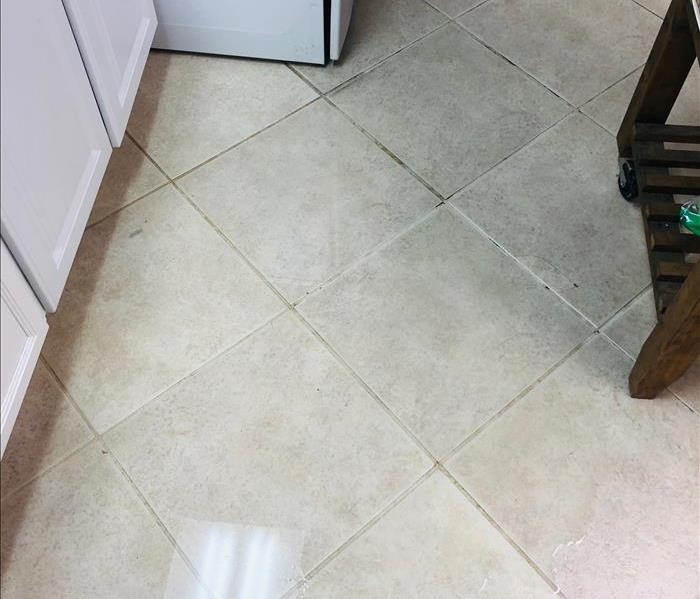 Water seeping into a home from a rainstorm.
Water seeping into a home from a rainstorm.
California renter’s rights protect tenants from expensive repair costs, including water damage.
Southern California experienced torrential rains ... forcing hundreds of residents to evacuate, opening sink holes and causing dangerous mudslides — one of the strongest storms in years for the area.
Most cities have fire departments willing and able to help when flood emergencies arise, especially if the situation is life-threatening. Flooding can cause electrical hazards. "Never turn power on or off yourself or use an electrical tool or appliance while standing in water," warns the National Center for Disease Control website.
Many buildings have an electrical shut-off box outside the unit on a main electrical panel. Find out where the electric shut-off switch is before a disaster.
Another concern is contamination from sewage in standing water. "Discard food that may have been in contact with floodwaters," recommends the Governor's Office of Emergency Services (www.oes.ca.gov).
Once the water flow has been staunched, there probably will be damage to repair.
"Tenants have a right to decent housing, free from habitability or code violations," said Ron Brown, director of the Human Rights and Fair Housing Commission in Sacramento.
Both state and local housing codes require landlords to maintain their property for renters in habitable condition. This covers dwelling needs that include effective waterproofing, weather protection and heating facilities that are in good working order.
Most laws focus on health and safety issues. Basic details can be found through the California Department of Consumer Affairs site at www.dca.ca.gov/legal/landlordbook.
Tenants have a duty under state law to inform the landlord promptly of needed repairs, preferably in writing. Vivid details, such as "water is coming in through my front door through a low spot when it rains," are useful. If possible, take photographs of the problem. Follow up with a friendly phone call.
Although tenants on the scene can stem the tide of damage, repairs should not be undertaken without going through proper channels.
State law allows landlords about 30 days to do most repairs. What if the landlord ignores written notice for flood or other repair work? If a unit is uninhabitable and 30 days have passed, tenants have several options, including making repairs and deducting them from the rent, withholding the rent, suing the landlord and moving.
Under State Civil Code 1941, the repair-and-deduct remedy may be applied only twice in a 12-month period and cannot exceed the monthly rental amount.
What if a tenant thinks the rent should be withheld because the place is uninhabitable? If damage amounts to more than two months' rent, be prepared to provide proof. And be aware that putting a dollar value on the inconvenience of wet carpet and fans running 24 hours to dry it out may be tricky to prove.
If rent is withheld, the situation can get complicated. According to the California Department of Consumer Affairs, "if a landlord brings an eviction action against a tenant for nonpayment of rent, and the unit is found to be uninhabitable, the landlord is liable to the tenant for reasonable attorney's fees and court costs."
Several new laws took effect Jan. 1, 2004. In a supplement to State Civil Code 1941.1, California law prohibits a landlord from collecting or demanding rent on an uninhabitable dwelling. The law also allows tenants to seek damages after inspection by a housing official. A notice of violation has to have been issued to the landlord, and the violation must have remained 60 days after the landlord received notice before a suit can be filed.
Consulting a legal professional is always a good idea before deducting rent or bringing a lawsuit.
To read this article from the Los Angeles Times cllick the link:
Los Angeles Times
Suffering a water loss can be a hectic and stressful time. Emotions run high and often times you don’t even know where to start! The first step should always be to identify the source of incoming water then shutoff or stop the water source if possible. Next make sure to turn off all electrical appliances around the affected area to reduce electrical hazards and turn off the circuit breakers supplying electricity to the wet areas. You will want to remove excess water by mopping or blotting and make sure to never use a regular vacuum to remove water! Keep furniture safe from additional damage by placing aluminum foil or wood blocks between furniture legs and wet carpeting/flooring and make sure to call SERVPRO of West Riverside City at (951)-351-8033 to come assess the damage and get the drying process started immediately. Since we are locally owned and operated, we are able to respond quickly and with the right resources. A fast response lessens the damage, limits further damage, and reduces the restoration cost.
California Water Damage and Renter’s Rights
3/7/2019 (Permalink)
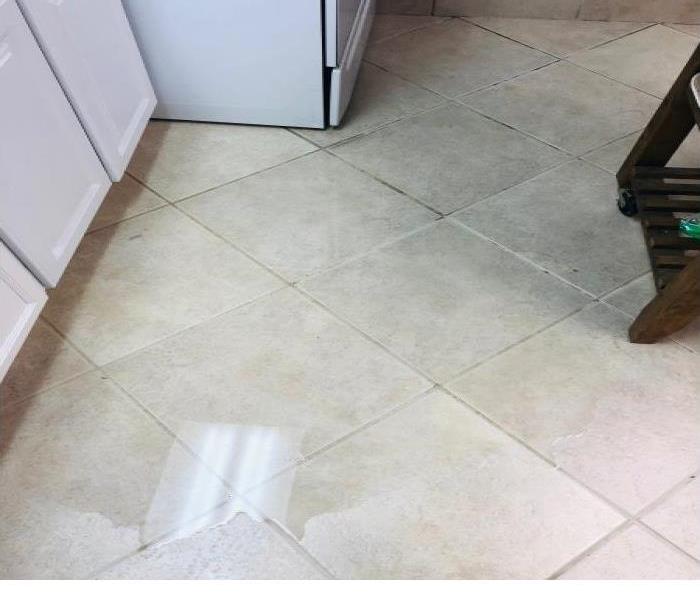 Water seeping into a home from a rainstorm.
Water seeping into a home from a rainstorm.
California renter’s rights protect tenants from expensive repair costs, including water damage.
Southern California experienced torrential rains ... forcing hundreds of residents to evacuate, opening sink holes and causing dangerous mudslides — one of the strongest storms in years for the area.
Most cities have fire departments willing and able to help when flood emergencies arise, especially if the situation is life-threatening. Flooding can cause electrical hazards. "Never turn power on or off yourself or use an electrical tool or appliance while standing in water," warns the National Center for Disease Control website.
Many buildings have an electrical shut-off box outside the unit on a main electrical panel. Find out where the electric shut-off switch is before a disaster.
Another concern is contamination from sewage in standing water. "Discard food that may have been in contact with floodwaters," recommends the Governor's Office of Emergency Services (www.oes.ca.gov).
Once the water flow has been staunched, there probably will be damage to repair.
"Tenants have a right to decent housing, free from habitability or code violations," said Ron Brown, director of the Human Rights and Fair Housing Commission in Sacramento.
Both state and local housing codes require landlords to maintain their property for renters in habitable condition. This covers dwelling needs that include effective waterproofing, weather protection and heating facilities that are in good working order.
Most laws focus on health and safety issues. Basic details can be found through the California Department of Consumer Affairs site at www.dca.ca.gov/legal/landlordbook.
Tenants have a duty under state law to inform the landlord promptly of needed repairs, preferably in writing. Vivid details, such as "water is coming in through my front door through a low spot when it rains," are useful. If possible, take photographs of the problem. Follow up with a friendly phone call.
Although tenants on the scene can stem the tide of damage, repairs should not be undertaken without going through proper channels.
State law allows landlords about 30 days to do most repairs. What if the landlord ignores written notice for flood or other repair work? If a unit is uninhabitable and 30 days have passed, tenants have several options, including making repairs and deducting them from the rent, withholding the rent, suing the landlord and moving.
Under State Civil Code 1941, the repair-and-deduct remedy may be applied only twice in a 12-month period and cannot exceed the monthly rental amount.
What if a tenant thinks the rent should be withheld because the place is uninhabitable? If damage amounts to more than two months' rent, be prepared to provide proof. And be aware that putting a dollar value on the inconvenience of wet carpet and fans running 24 hours to dry it out may be tricky to prove.
If rent is withheld, the situation can get complicated. According to the California Department of Consumer Affairs, "if a landlord brings an eviction action against a tenant for nonpayment of rent, and the unit is found to be uninhabitable, the landlord is liable to the tenant for reasonable attorney's fees and court costs."
Several new laws took effect Jan. 1, 2004. In a supplement to State Civil Code 1941.1, California law prohibits a landlord from collecting or demanding rent on an uninhabitable dwelling. The law also allows tenants to seek damages after inspection by a housing official. A notice of violation has to have been issued to the landlord, and the violation must have remained 60 days after the landlord received notice before a suit can be filed.
Consulting a legal professional is always a good idea before deducting rent or bringing a lawsuit.
To read this article from the Los Angeles Times cllick the link:
Los Angeles Times
Suffering a water loss can be a hectic and stressful time. Emotions run high and often times you don’t even know where to start! The first step should always be to identify the source of incoming water then shutoff or stop the water source if possible. Next make sure to turn off all electrical appliances around the affected area to reduce electrical hazards and turn off the circuit breakers supplying electricity to the wet areas. You will want to remove excess water by mopping or blotting and make sure to never use a regular vacuum to remove water! Keep furniture safe from additional damage by placing aluminum foil or wood blocks between furniture legs and wet carpeting/flooring and make sure to call SERVPRO of West Riverside City at (951)-351-8033 to come assess the damage and get the drying process started immediately. Since we are locally owned and operated, we are able to respond quickly and with the right resources. A fast response lessens the damage, limits further damage, and reduces the restoration cost.
Preparing for Santa Ana Wind storms in Riverside
2/13/2019 (Permalink)
Santa Ana winds can occur at any time!
The Santa Ana winds are strong, extremely dry downslope winds that originate inland and affect coastal Southern California and northern Baja California. They originate from cool, dry high-pressure air masses in the Great Basin.
Santa Ana winds are known for the hot, dry weather that they bring in autumn (often the hottest of the year), but they can also arise at other times of the year. They often bring the lowest relative humidities of the year to coastal Southern California. These low humidities, combined with the warm, compressionally-heated air mass, plus high wind speeds, create critical fire weather conditions.
If you live in a place prone to windstorms or you know one is coming, then pay close attention to what it takes to prepare. If you currently have a damaged roof or any sign of a roof leak, then your home may not be sound enough to withstand a windstorm. You need to take proper precautions. This may mean repairing any weak areas or covering them so they do not get worse. Here is a list of what you should look out for:
• Broken skylights
• Cracked windows
• Damaged siding
• Missing shingles
Wind Damage
A windstorm may cause a variety of problems to your business or home. On one hand, it may blow off shingles, throw debris at your home or lead to damaged siding. You need to be prepared for just about anything. Not only can the wind cause damage, but the debris the wind brings with it can also. Hard objects can knock shingles off, and large trees may break through your roofing entirely. All of this can lead to a roof leak and further damage.
Cleanup Process
Once the wind has done its damage, it’s time to pick up the pieces. For any damage done to the roof, tarps can be used to cover gaps created by the missing shingles. These tarps will help keep rain from entering your business while you work on restoration. You want to make sure that you do not have any further water damage. Additionally, you can use plywood to cover the holes on the roof. While repairing the building is one thing, you also want to make sure no other issues arise.
A windstorm can cause costly, extensive damage to your Riverside home or business. The best course of action is to reduce the risk wind can cause. Whether you have a roof leak or something more dangerous, don’t let any problems sit until they get worse. In some cases, a professional service may be helpful.
When Is Wind Damage Covered By Homeowners Insurance?
Windstorms are among the perils generally covered by homeowners insurance. Some homeowners policies exclude coverage for wind damage, though. It's a good idea to read your policy to learn whether it includes coverage for wind damage.
If your homeowners insurance policy includes coverage for windstorms, two types of protection may help you after a windstorm damages your home:
- Dwelling coverage, which helps protect a home's structure, may help pay for repairs if wind damages your home's roof, siding or windows, for example.
- Personal property coverage may help pay to replace the contents of your home if they are damaged by wind -- or by rain, snow, sleet, sand or dust that the wind drives inside after damaging your home's structure.
If your home has sustained damage due to a windstorm, call your neighborhood SERVPRO of West Riverside City. Whether a tree has fallen on your home or you see signs of leak due to damage to your roof from winds, we are here to help!
Is it Time to Contact a Storm Restoration Expert?
1/21/2019 (Permalink)
As a homeowner, you probably don't want to have to think about your roof leak or getting a roof repair.
You probably don't want to deal with flooding, rain damage, or wind damage. Unfortunately, it might be time to contact a home restoration expert to deal with storm remediation. If you've been thinking about home restoration or water restoration, the time to get started is now. If you aren't sure whether it's time to reach out to a storm restoration or home restoration expert, there are a few things you need to consider.
Have you recently experienced a severe storm?
If you have recently experienced flooding, storm damage, or wind damage, your house may have been physically damaged and you may need storm remediation. Many homeowners don't realize just how severe roof damage, rain damage, wind damage, and ground water can be after a severe storm. Pay attention to when there are storms in your area, as any place that is prone to rain or wind damage may be susceptible to problems.
Does your home have standing ground water?
Does your area frequently have flooding due to high rains? Ground water after flooding? Standing flood water in your yard or home? It could be time to seek storm remediation. A water restoration expert can help to remove ground water with a flood pump. Did you know that a flood pump can be used by a water restoration expert to remove water? A flood pump can effectively remove water from your house. Make sure you contact a water restoration and storm restoration professional when you're ready for someone to use a flood pump at your house.
Is there visible damage to your home?
If you experience storm damage, or wind damage in your area, make sure you visually inspect your home. Do you have a roof leak from roof damage? Do you need a roof repair? Wind damage, roof damage, and a roof leak can all impact your house. Wind damage can be present in many different ways. For example, wind damage can impact the siding on your home, but wind damage can also cause a tree to fall onto your roof. This can lead to roof damage and a roof leak. Unfortunately, this means you'll need a roof repair.
Tree fall on your home? Advise & information about what to do if this happens to you.
With recent storms trees are falling causing damage everywhere, including homes in Riverside! Damage can be significant and there are many homeowners that don't know where to start in this situation. SERVPRO of West Riverside City can help.
Here is some information and advise on what to do should this happen to you.
Usually trees don't fall just because they are old. The rain water can become overwhelming in the ground making it soft and tree roots do not hold well in soft, wet dirt. This along with strong wind surges cause the tree to fall, wind pulls the tree right up from the soft ground causing the fall.
If the tree does hit your home there will likely be damage, depending on the size of the tree the amount of damage can vary. Here are the basic steps to take to secure your home:
- If you are in the home when the fall occurs, immediate walk out-side and visually look at your home for damage. Use an entrance far from the tree if possible. IE: If the main entrance is blocked, go out the back door.
- Call your local Fire or Police and advise them of the tree fall, sometimes there can be street wires that go down with the tree. If this is a problem the local authorities will help secure the area for safety.
- Call your Insurance Carrier and report a claim for the damage to your home. Get a claim number and you adjusters contact information. Also make sure they explain the claim process and how your insurance coverage applies in this situation.
- Call a Tree Company to have the tree professionally removed. Your insurance carrier may assign a company, if not ask for recommendations. DO NOT attempt yourself, this is very dangerous!
- Call SERVPRO of West Riverside City to begin mitigation of the damage. Also to board or secure areas of the house that is needed. The sooner we begin mitigation the better. Damage can get worse the longer it waits.
- Once all of this is done, begin looking for a contractor if any reconstruction is needed.
At the end of the process we at SERVPRO of West Riverside City will make it "Like it never even happened"
We are available 24/7 and 365 days a year for emergency services at 951-351-8033 or visit our website. Click "Request Service Online"
Coping with Disaster and Understanding Disaster Events
12/5/2018 (Permalink)
Understand Disaster Events
The emotional toll that disaster brings can sometimes be even more devastating than the financial strains of damage and loss of home, business, or personal property.
- Everyone who sees or experiences a disaster is affected by it in some way.
- It is normal to feel anxious about your own safety and that of your family and close friends.
- Profound sadness, grief, and anger are normal reactions to an abnormal event.
- Acknowledging your feelings helps you recover.
- Focusing on your strengths and abilities helps you heal.
- Accepting help from community programs and resources is healthy.
- Everyone has different needs and different ways of coping.
- It is common to want to strike back at people who have caused great pain.
Children and older adults are of special concern in the aftermath of disasters. Even individuals who experience a disaster “second hand” through exposure to extensive media coverage can be affected.
Contact local faith-based organizations, voluntary agencies, or professional counselors for counseling. Additionally, FEMA and State and local governments of the affected area may provide crisis counseling assistance. The SAMHSA Disaster Distress Helpline is a national hotline dedicated to providing year-round immediate crisis counseling for individuals experiencing emotional distress related to any natural or human-caused disaster.
As you recover, it is a good idea to make sure that you have updated your family disaster plan and replenished essential disaster supplies just in case a disaster happens again. You will always feel better knowing that you are prepared and ready for anything.
Recognize Signs Of Disaster-Caused Stress
Seek counseling if you or a family member are experiencing disaster-caused stress. When adults have the following signs, they might need crisis counseling or stress management assistance:
- Difficulty communicating thoughts.
- Difficulty sleeping.
- Difficulty maintaining balance in their lives.
- Low threshold of frustration.
- Increased use of drugs/alcohol.
- Limited attention span.
- Poor work performance.
- Headaches/stomach problems.
- Tunnel vision/muffled hearing.
- Colds or flu-like symptoms.
- Disorientation or confusion.
- Difficulty concentrating.
- Reluctance to leave home.
- Depression, sadness.
- Feelings of hopelessness.
- Mood-swings and easy bouts of crying.
- Overwhelming guilt and self-doubt.
- Fear of crowds, strangers, or being alone.
Easing Disaster-Caused Stress
Talk to someone and seek professional help for disaster-caused stress. The following are ways to ease post-disaster stress:
- Talk with someone about your feelings - anger, sorrow, and other emotions - even though it may be difficult.
- Seek help from professional counselors who deal with post-disaster stress.
- Do not hold yourself responsible for the disastrous event or be frustrated because you feel you cannot help directly in the rescue work.
- Take steps to promote your own physical and emotional healing by healthy eating, rest, exercise, relaxation, and meditation.
- Maintain a normal family and daily routine, limiting demanding responsibilities on yourself and your family.
- Spend time with family and friends.
- Participate in memorials.
- Use existing support groups of family, friends, and religious institutions.
Ensure you are ready for future events by restocking your disaster supplies kits and updating your family disaster plan. Doing these positive actions can be comforting.
Helping Kids Cope With Disaster
Disasters can leave children feeling frightened, confused, and insecure. Whether a child has personally experienced trauma, has merely seen the event on television, or has heard it discussed by adults, it is important for parents and teachers to be informed and ready to help if reactions to stress begin to occur.
Children may respond to disaster by demonstrating fears, sadness or behavioral problems. Younger children may return to earlier behavior patterns, such as bedwetting, sleep problems, and separation anxiety. Older children may also display anger, aggression, problems in school, or withdrawal. Some children who have only indirect contact with the disaster but witness it on television may develop distress.
Recognize Risk Factors
For many children, reactions to disasters are brief and represent normal reactions to "abnormal events." A smaller number of children can be at risk for more enduring psychological distress as a function of three major risk factors:
- Direct exposure to the disaster, such as being evacuated, observing injuries to or the death of others, or experiencing injury along with fearing one’s life is in danger.
- Loss/grief caused by the death or serious injury of family or friends.
- On-going stress from the secondary effects of disaster, such as temporarily living elsewhere, loss of friends and social networks, loss of personal property, parental unemployment, and costs incurred during recovery to return the family to pre-disaster life and living conditions.
Vulnerabilities in Children
In most cases, depending on the risk factors above, distressing responses are temporary. In the absence of severe threat to life, injury, loss of loved ones, or secondary problems such as loss of home, moves, etc., symptoms usually diminish over time. For those that were directly exposed to the disaster, reminders of the disaster such as high winds, smoke, cloudy skies, sirens, or other reminders of the disaster may cause upsetting feelings to return. Having a prior history of some type of traumatic event or severe stress may contribute to these feelings.
Children’s coping with disaster or emergencies is often tied to the way parents cope. They can detect adults’ fears and sadness. Parents and adults can make disasters less traumatic for children by taking steps to manage their own feelings and plans for coping. Parents are almost always the best source of support for children in disasters. One way to establish a sense of control and to build confidence in children before a disaster is to engage and involve them in preparing a family disaster plan. After a disaster, children can contribute to a family recovery plan.
Meeting the Child’s Emotional Needs
Children’s reactions are influenced by the behavior, thoughts, and feelings of adults. Adults should encourage children and adolescents to share their thoughts and feelings about the incident. Clarify misunderstandings about risk and danger by listening to children’s concerns and answering questions. Maintain a sense of calm by validating children’s concerns and perceptions and with discussion of concrete plans for safety.
Listen to what the child is saying. If a young child is asking questions about the event, answer them simply without the elaboration needed for an older child or adult. Some children are comforted by knowing more or less information than others; decide what level of information your particular child needs. If a child has difficulty expressing feelings, encourage the child to draw a picture or tell a story of what happened.
Try to understand what is causing anxieties and fears. Be aware that following a disaster, children are most afraid that:
- The event will happen again.
- Someone close to them will be killed or injured.
- They will be left alone or separated from the family.
Reassuring Children After a Disaster
Suggestions to help reassure children include the following:
- Personal contact is reassuring. Hug and touch your children.
- Calmly provide factual information about the recent disaster and current plans for insuring their safety along with recovery plans.
- Encourage your children to talk about their feelings.
- Spend extra time with your children such as at bedtime.
- Re-establish your daily routine for work, school, play, meals, and rest.
- Involve your children by giving them specific chores to help them feel they are helping to restore family and community life.
- Praise and recognize responsible behavior.
- Understand that your children will have a range of reactions to disasters.
- Encourage your children to help update your family disaster plan.
If you have tried to create a reassuring environment by following the steps above, but your child continues to exhibit stress, if the reactions worsen over time, or if they cause interference with daily behavior at school, at home, or with other relationships, it may be appropriate to talk to a professional. You can get professional help from the child’s primary care physician, a mental health provider specializing in children’s needs, or a member of the clergy.
Monitor and Limit Exposure to the Media
News coverage related to a disaster may elicit fear and confusion and arouse anxiety in children. This is particularly true for large-scale disasters or a terrorist event where significant property damage and loss of life has occurred. Particularly for younger children, repeated images of an event may cause them to believe the event is recurring over and over.
If parents allow children to watch television or use the Internet where images or news about the disaster are shown, parents should be with them to encourage communication and provide explanations. This may also include parent’s monitoring and appropriately limiting their own exposure to anxiety-provoking information.
Use Support Networks
Parents help their children when they take steps to understand and manage their own feelings and ways of coping. They can do this by building and using social support systems of family, friends, community organizations and agencies, faith-based institutions, or other resources that work for that family. Parents can build their own unique social support systems so that in an emergency situation or when a disaster strikes, they can be supported and helped to manage their reactions. As a result, parents will be more available to their children and better able to support them. Parents are almost always the best source of support for children in difficult times. But to support their children, parents need to attend to their own needs and have a plan for their own support.
Preparing for disaster helps everyone in the family accept the fact that disasters do happen and provides an opportunity to identify and collect the resources needed to meet basic needs after disaster. Preparation helps; when people feel prepared, they cope better and so do children.
Thunderstorm Safety & How to Prepare- Tips from you neighbors at SERVPRO West Riverside City
11/21/2018 (Permalink)
Last months thunderstorms inspired us here at SERVPRO of West Riverside to share some thunderstorm safety information and give some tips on how to prepare for a storm.
Did you know SERVPRO of West Riverside City is a proud partner with the American Red Cross? According to the Red Cross, A thunderstorm is considered severe if it produces wind gusts of at least 58 miles per hour. Every thunderstorm produces lightning, which kills more people each year than tornadoes or hurricanes. Heavy rain from thunderstorms can cause flash flooding, and high winds can damage homes and blow down tree and utility poles - causing widespread power outages.
WATCH vs. WARNING
Watch: Severe thunderstorms are possible in and near the watch area
Warning: Severe weather has been reported by spotters or indicated by radar. Warnings indicate imminent danger to life and property.
Be Prepared
Learn about your local community’s emergency warning system for severe thunderstormsPick a safe place in your home for household members to gather during a thunderstorm This should be away from windows, skylights and glass doors that could be broken by strong winds or hailMake a list of items to bring inside in the event of a severe thunderstormMake trees and shrubbery more wind resistant by keeping them trimmed and removing damaged branchesProtect your animals by ensuring that any outside buildings that house them are protected in the same way as your homeMake Preparedness Kit
Water—one gallon per person, per dayFood—non-perishable, easy-to-prepareFlashlightBattery-powered or hand-crank radio (NOAA Weather Radio, if possible)Extra batteriesFirst aid kitMedications (7-day supply) and medical itemsMulti-purpose toolSanitation & personal hygiene itemsCopies of personal documentsCell phone with chargersFamily & emergency contact informationExtra cashFinal Step
Call SERVPRO of West Riverside City at 951.351.8033 if your home or business experiences damages from a storm. We have the resources to handle any size disaster.
There's a reason they say we are "Faster to any Disaster!"
For more information, visit the Red Cross website: Red Cross website
Prepare For Emergencies Now: Information For Pet Owners.
9/25/2018 (Permalink)
 SERVPRO West Riverside City mascot, Ellie, is ready for any emergency!
SERVPRO West Riverside City mascot, Ellie, is ready for any emergency!
Preparing Your Pets for Emergencies Makes Sense. Get Ready Now.
If you are like millions of animal owners nationwide, your pet is an important member of your household. The likelihood that you and your animals will survive an emergency such as a fire or flood, tornado or terrorist attack depends largely on emergency planning done today. Some of the things you can do to prepare for the unexpected, such as assembling an animal emergency supply kit and developing a pet care buddy system, are the same for any emergency. Whether you decide to stay put in an emergency or evacuate to a safer location, you will need to make plans in advance for your pets. Keep in mind that what’s best for you is typically what’s best for your animals. If you must evacuate, take your pets with you if possible. However, if you are going to a public shelter, it is important to understand that animals may not be allowed inside. Plan in advance for shelter alternatives that will work for both you and your pets. Make a back-up emergency plan in case you can’t care for your animals yourself. Develop a buddy system with neighbors, friends and relatives to make sure that someone is available to care for or evacuate your pets if you are unable to do so. Be prepared to improvise and use what you have on hand to make it on your own for at least three days, maybe longer.
SERVPRO Emergency Ready Profile
9/20/2018 (Permalink)
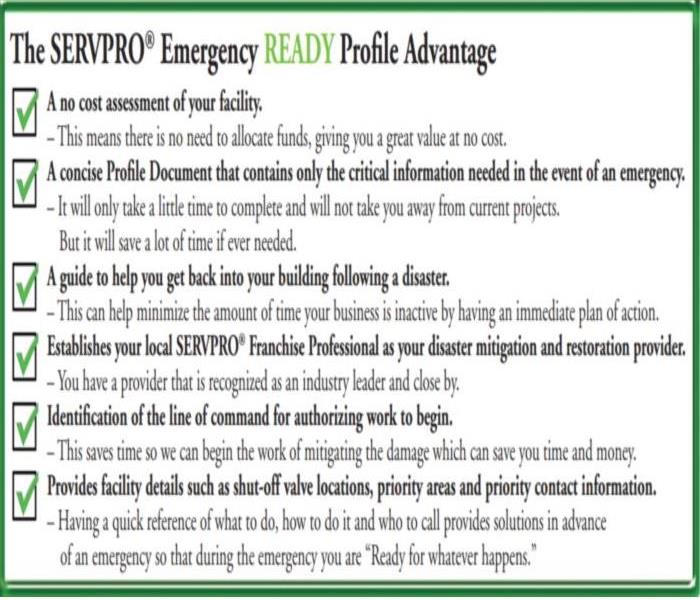 SERVPRO is a leader in water and fire damage response and can help you quickly get your property back in working order.
SERVPRO is a leader in water and fire damage response and can help you quickly get your property back in working order.
Are You "Ready for Whatever Happens" in Riverside?
Preparation is a key component for making it through any size disaster, whether it’s a small water leak, a large fire, or an area flood. The best time to plan for such events is not when the event happens, but well before it happens.
The SERVPROEmergency READY Profile serves as a quick reference of important building and contact information or can be an ideal supplement to any well-designed emergency preparedness or existing contingency program. Rather than simply reacting to disaster situations, most prefer proactive measures to establish a relationship with a restoration services company.
By working with SERVPRO of West Riverside City to develop your personalized Emergency READY Profile your business will receive the benefit of over 40 years of experience in reducing the impact of any natural or man-made disaster. SERVPRO is a leader in water and fire damage response and can help you quickly get your property back in working order.
Call us Today for a No Cost Assessment
of Your Facility!
Prepare for the unexpected, Water Damage, Flood or Storm
7/11/2018 (Permalink)
 Download the app and have SERVPRO help you prepare for the next emergency that might happen to your home or business
Download the app and have SERVPRO help you prepare for the next emergency that might happen to your home or business
Emergency Preparedness
is usually discussed a few times a year, particularly at the beginning of storm season and then left to collect dust on the corner of a desk. Everyone knows it’s an important subject however it’s one of those items that keeps getting pushed to the proverbial tomorrow. Most people have a “plan” to get out however very few people have a true plan to get back in.
No one plans on a disaster, but you can plan to be “Ready for whatever happens” and SERVPRO of West Riverside City wants to help you. SERVPRO has a tool designed to not only help you before the storm but also prepare you to get back to business after the storm. The Emergency Ready Profile is a no cost assessment of your property containing pertinent information about utilities, account #’s, priority contacts including your insurance. The profile is compiled on an App compatible with your smart device, therefore this information is always at your fingertips.
If you’re tired of looking at the unfinished plan on the corner of your desk and want to quickly and effectively make a plan to reduce business interruption as well as protect your property and investments
Call SERVPRO of West Riverside City today 951-351-8033
Why you need the SERVPRO ERP
1/30/2018 (Permalink)
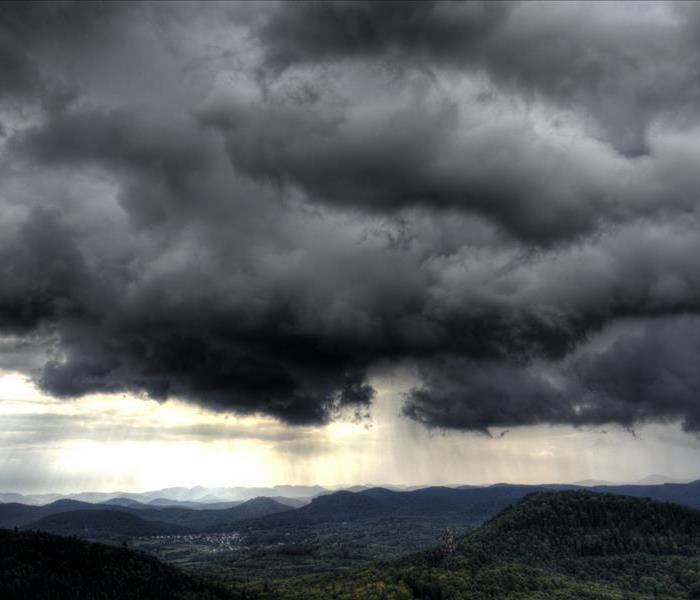 Be ready for whatever disaster that might strike!
Be ready for whatever disaster that might strike!
No matter where you live, it is important to be informed and prepared for any natural disaster that may occur. Natural disasters often strike without warning, leaving behind a trail of destruction and devastation. Though Mother Nature's disasters are often unpredictable, there are steps you can take to ensure you are prepared.
Contact SERVPRO of West Riverside City to establish an Emergency READY Profile (ERP) for your home and business property. SERVPRO's ERP serves as a quick reference document, detailing important building and contact information for your property in the event of an emergency. The ERP is an ideal supplement to any existing preparedness plan, or may be used as a standalone document. Knowing what to do and who to call in advance is the key to timely mitigation, and can minimize the effects of any weather-related disaster, water, or fire damage to your home or business.
When disaster strikes, make sure you have experienced professionals on the line. No matter how big or small, SERVPRO of West Riverside City will be ready to help make your property damage "Like it never even happened."
Heavy Rains Causes Roof Leak!
1/17/2018 (Permalink)
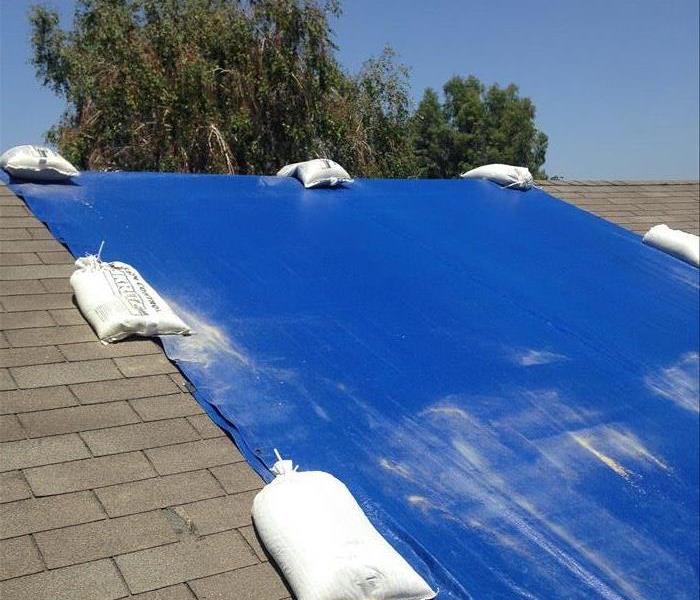 This photo shows a roof tarping of a roof with damages from a recent storm.
This photo shows a roof tarping of a roof with damages from a recent storm.
Let's be honest, how often do you really climb up onto your roof and check to make sure everything is looking one hundred percent? Probably not at all, I would assume that most people don't. It's not until they experience a storm damage that they realize their roof may not be in the best shape to be over their head. Recently storms rolled through Southern California and a lot of unhappy homeowners realized that their homes were NOT prepared for all the rain that we were receiving. Because the high winds and heavy rains were not a good combination and led to most water damages within the ceiling and/or in the home. SERVPRO should be your first call when it comes to any storm damage that you may experience.
Call us for an inspection if you think you might have a roof leak!
Storm Weather floods this Orange, CA Home
1/17/2018 (Permalink)
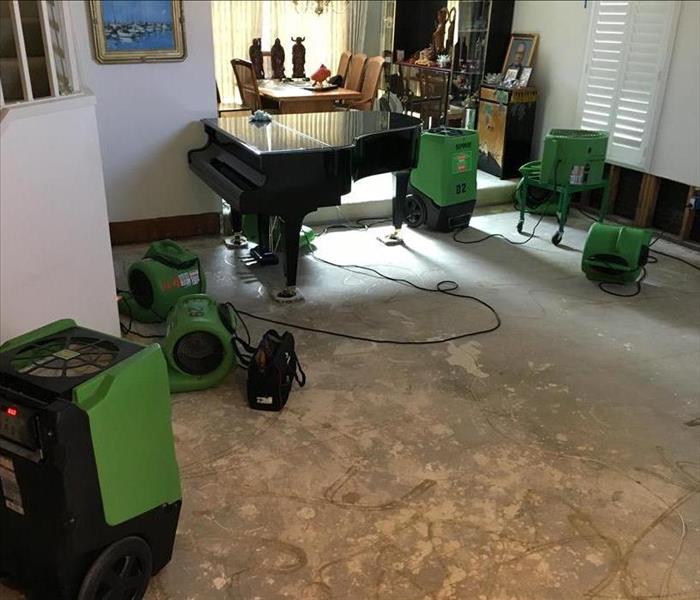 Drywall removed when flood water entered this living room in Orange, CA
Drywall removed when flood water entered this living room in Orange, CA
This home in Orange, CA was flooded with outdoor water. Flood water can carry bacteria and its important treat flood water damage a specific way. Affected materials like drywall, pad and carpet often have to be completely removed and replaced to make it safe again. SERVPRO of West Riverside City recommends removing the material at least 12 inches from where the water touched.
This home needed many of its walls cut thrown out along with their carpet and pad. The first photo shows the living room before anything was done, and the second photo shows our equipment drying out the structure and floor.
If you experience anything like a flood from the outside, please don't hesitate to call SERVPRO and get our professional opinion on what should be done!
Water Damage From Heavy Rain Storm
1/15/2018 (Permalink)
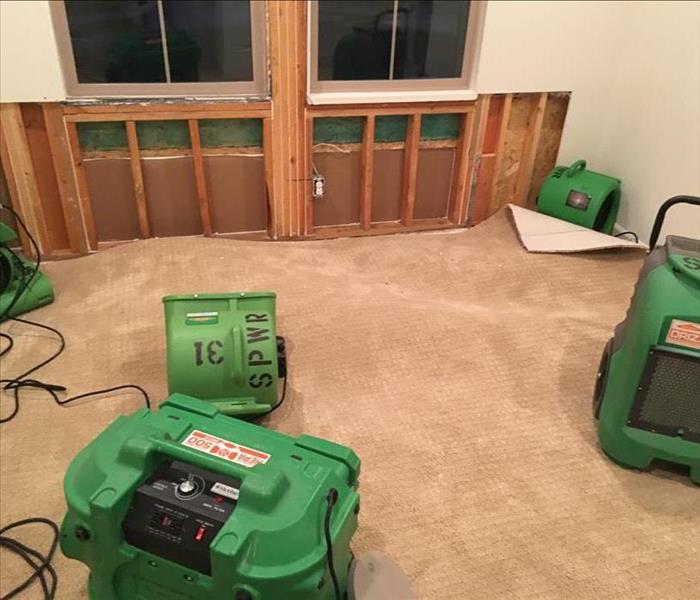 Water Damage affected wall under window from heavy rain
Water Damage affected wall under window from heavy rain
This customer experienced a water damage from the roof in a heavy rain storm in California. The first photo shows were most of the water came in, above the window! The after photo shows the demolition that had to be performed to dry out the home. SERVPRO of West Riverside City was able to complete the demolition and set equipment to dry the home within 24 hours. Our customer was expecting a much longer process and was thrilled that we were able to dry the home within four days. SERVPRO of West Riverside City is here to help 24-7!
If you have experienced any water damage in the last rains please don't hesitate to get professional help to clean and dry out your structure!
Roof Leak from Rain Storm in Riverside, CA
1/15/2018 (Permalink)
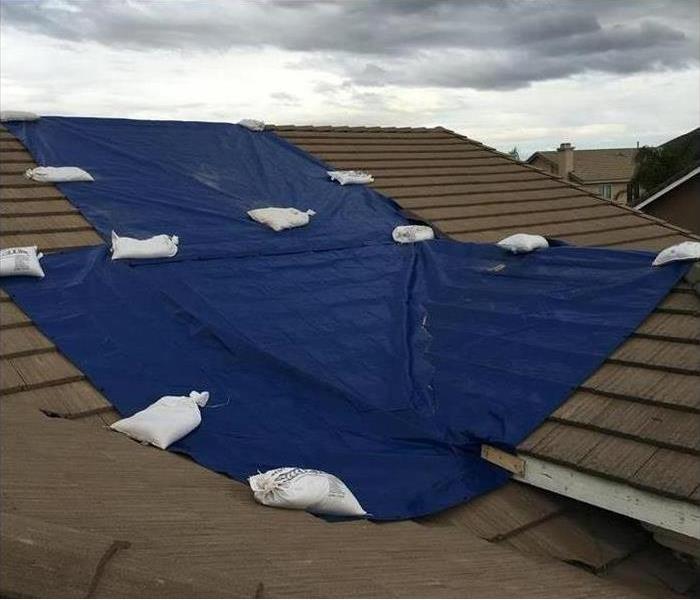 Roof Leak Repair after Rain Storm in Riverside, CA
Roof Leak Repair after Rain Storm in Riverside, CA
Once again the time of the rains have come. Although they may be short or very light, a surprise storm could always be just around the corner. Here we have a situation were a storm had enough strength to more some of the roof tiles around and cause a water leak that worked its way into the clients home. We received the call and quickly determined the general area it was coming from in the roof. With all the precautions in place, we were able to help the client with a tarp over the area strong enough to hold off the rain until it could receive proper attention and repairs.
Highly Trained Restoration Specialists
Our SERVPRO Professionals are highly trained in property restoration. From initial and ongoing training at SERVPRO's Corporate Training Facility to regular IICRC industry certifications, our Professionals are equipped with the knowledge to restore your property. The SERVPRO training program includes the follow:
- IICRC Training
- Employee Certification Training
- Initial Franchise Training
- e-Learnings
- Continuing Education Classes
Disaster Preparedness
1/2/2018 (Permalink)
 Be Informed and Ready if a disaster where to strike.
Be Informed and Ready if a disaster where to strike.
Build A Kit
Make sure your emergency kit is stocked with the items on the checklist below. Most of the items are inexpensive and easy to find, and any one of them could save your life. Headed to the store? Download a printable version to take with you. Once you take a look at the basic items, consider what unique needs your family might have, such as supplies for pets, or seniors.
After an emergency, you may need to survive on your own for several days. Being prepared means having your own food, water and other supplies to last for at least 72 hours. A disaster supplies kit is a collection of basic items your household may need in the event of an emergency.
Basic Disaster Supplies Kit
To assemble your kit, store items in airtight plastic bags and put your entire disaster supplies kit in one or two easy-to-carry containers such as plastic bins or a duffel bag.
A basic emergency supply kit could include the following recommended items:
- Water - one gallon of water per person per day for at least three days, for drinking and sanitation
- Food - at least a three-day supply of non-perishable food
- Battery-powered or hand crank radio and a NOAA Weather Radio with tone alert
- Flashlight
- First aid kit
- Extra batteries
- Whistle to signal for help
- Dust mask to help filter contaminated air and plastic sheeting and duct tape to shelter-in-place
- Moist towelettes, garbage bags and plastic ties for personal sanitation
- Wrench or pliers to turn off utilities
- Manual can opener for food
- Local maps
- Cell phone with chargers and a backup battery
Download the Recommended Supplies List (PDF)
Additional Emergency Supplies
Consider adding the following items to your emergency supply kit based on your individual needs:
- Prescription medications
- Non-prescription medications such as pain relievers, anti-diarrhea medication, antacids or laxatives
- Glasses and contact lense solution
- Infant formula, bottles, diapers, wipes, diaper rash cream
- Pet food and extra water for your pet
- Cash or traveler's checks
- Important family documents such as copies of insurance policies, identification and bank account records saved electronically or in a waterproof, portable container
- Sleeping bag or warm blanket for each person
- Complete change of clothing appropriate for your climate and sturdy shoes
- Household chlorine bleach and medicine dropper to disinfect water
- Fire extinguisher
- Matches in a waterproof container
- Feminine supplies and personal hygiene items
- Mess kits, paper cups, plates, paper towels and plastic utensils
- Paper and pencil
- Books, games, puzzles or other activities for children
Maintaining Your Kit
After assembling your kit remember to maintain it so it’s ready when needed:
Keep canned food in a cool, dry place
Store boxed food in tightly closed plastic or metal containers
Replace expired items as needed
Re-think your needs every year and update your kit as your family’s needs change.
Kit Storage Locations
Since you do not know where you will be when an emergency occurs, prepare supplies for home, work and vehicles.
Home: Keep this kit in a designated place and have it ready in case you have to leave your home quickly. Make sure all family members know where the kit is kept.
Work: Be prepared to shelter at work for at least 24 hours. Your work kit should include food, water and other necessities like medicines, as well as comfortable walking shoes, stored in a “grab and go” case.
Vehicle: In case you are stranded, keep a kit of emergency supplies in your car.
Read more here to be prepared for any kind of natural disaster that might occur.
Make your business ready for any emergency
12/29/2017 (Permalink)
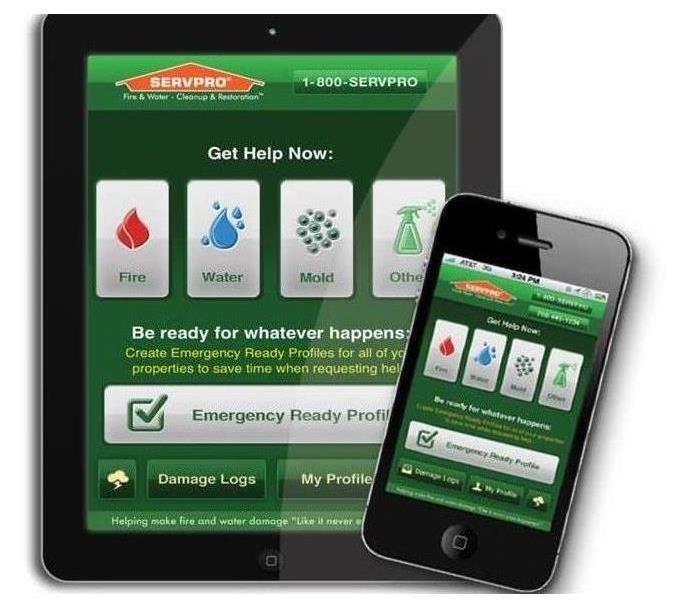 Riverside Businesses Benefit from Using the SERVPRO ERP Plan
Riverside Businesses Benefit from Using the SERVPRO ERP Plan
Use SERVPRO's ERP Plan to Help Prevent and Mitigate Losses
Water has the potential to damage any business. A broken pipe or leaking faucet in your Riverside business could lead to temporary closure or water damage to equipment or furnishings such as your carpet or drapes. Any closure or destruction is bad news for your business because not only do you lose money when you are closed, but you also have to pay to replace any damaged items. That is why SERVPRO recommends salons have a water removal plan in place to guide you should the worst happen.
Your Riverside business might need water removal at any time. You cannot always prevent leaks or spills from occurring, but you can draw up an emergency plan so that you and your staff know what to do and whom to call in the case of an emergency. We recommend including these key points.
Who to call in an emergency: Make sure everyone knows whom to call when something happens. Include managers, emergency services if necessary, and of course, do not forget to add SERVPRO. Our IICRC-certified technicians have free standing and truck mounted pumps and a range of extraction tools on hand to deal with any water removal needs.
The chain of command: Your staff needs to know whom to call and who is responsible for each aspect of the cleanup and water removal operation.
Insurance details: Ensure everyone knows how to contact your insurers and has all the insurance details to hand. Not all business insurance covers water removal so make sure you have the right coverage in place before anything happens.
Action steps: Set out a list of action steps to take, for example moving items to a higher position, or stopping the flow of water until the emergency services arrive, if possible.
Plan for reopening: The idea is to get your business up and running again as fast as possible. Have a plan in place to make the process smoother and easier.
The SERVPRO Ready Profile Plan has an easy to use app that makes it easy for business owners to plan for water removal and other incidents. You get the guidance you need to assess your premises and draw up an emergency plan, and also receive downloadable forms and plans you can use in an emergency.
For help with water removal in Riverside and surrounding areas, call SERVPRO of West Riverside City at 951-351-8033 today.
Learn more about making your business ready for any emergency here!
Will Your Roof Leak This Year?
12/1/2016 (Permalink)
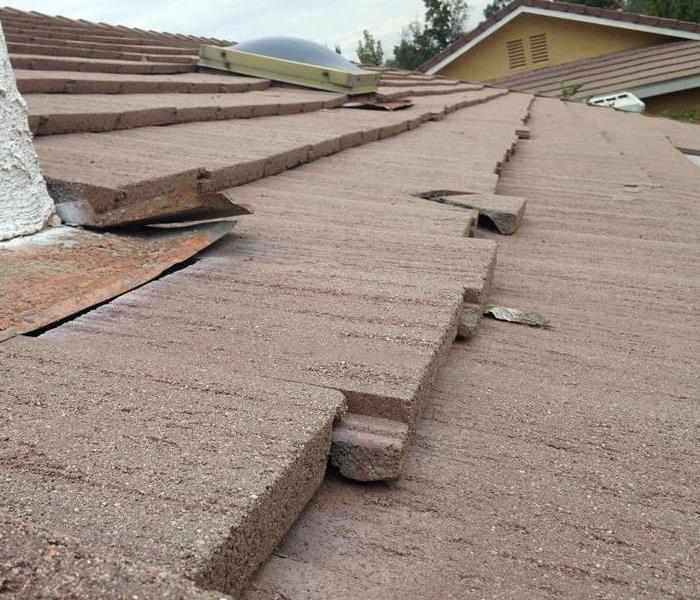 A home roof in Riverside CA with some sipped and cracked tiles...
A home roof in Riverside CA with some sipped and cracked tiles...
Got leaks?
The weather in southern California is hard to beat. We get lots of sunshine, low humidity and a nice long summer to accommodate for all of our activities. However, this is exactly why we can get in trouble when we enter our short rain season. We don't get much rain so we assume our roofs are in good shape, often times not thinking twice on giving them some maintenance work from time to time...
During this potential rainy season, we will receive many calls from homeowners that will unfortunately have water damage in their homes due to roof leaks. Many can not be prevented if we have a heavy storm but the vast majority can actually be prevented. So lets take a look at some of the very common situations we come across.
Slipped Tiles: These can be ceramic tiles or concrete tiles. both have some nice weight to them and can usually withstand some heavy winds. But from time to time and over time, these heavier tiles can slip or slide away from their original position creating gaps in the surface area where potential water damage can occur. Wind, heavy water flow and the weight of the tiles settling in over years can all cause this "slippage". Also, broken tiles from objects impacting them can be a problem along with the occasional cracked tile from someone walking on it...
Missing Shingles: This is more topical of your asphalt shingle roofing. Asphalt shingles are very popular and perhaps the most commonly used. Their appearance is like that of sandpaper some say. They have good durability and usually come with a smaller price tag. With this kind of roofing we usually see "missing shingles". It is typical wear-and-tear that usually makes this happen. Over time heavy winds can eventually lift a shingle and continually work it to the point it detaches. Bad installation can also result in compromised performance when storms or wind hits.
Wind Driven Damage: This can and will happen to basically any type of roof. Wind driven damage is a term used to describe a situation where the wind was strong enough to be the main reason behind the damage. Strong wind can blow out weak or poorly installed shingles but when coupled with rain, it can actually force water to move up and under the roof shingles regardless of type. Water will usually find its way into the attic. In a situation we encounters not to long ago. Hail was present during a strong and windy storm. The wind was strong enough to push the smaller hail pellets up and under the roof shingles. The home owner thought the worst was over after the storm was done. However, it did not take to long for the hail deposited in his attic to start melting and cause massive water damage.
Tips:
1) We recommend doing a yearly routine inspection of the roof ether by carefully doing the inspection yourself or getting a professional to do it for you. We strongly recommend getting help to do this inspection if you are not comfortable doing this yourself. It can be dangerous work if not handled properly.
2) Also, have your gutters cleaned out to prevent water from pooling along the gutter and flowing into the attic.
3) Pay close attention to wood shake shingles if you have them. They can be very easily damaged when old or worn out.
4) Don't forget that many times your home owners insurance can help in situations like this. Always check with your insurance agent first before putting in a claim.
5) Finally, getting an inspection from a trusted service provider that works with all insurance companies like ourselves can be of great value in keeping cost and time spent down should anything happen.
We hope this helps out and helps keep you dry and leak free!
 Storm and flood losses can both equally impact and threaten your home. Contact SERVPRO of West Riverside for your Riverside home storm damage.
Storm and flood losses can both equally impact and threaten your home. Contact SERVPRO of West Riverside for your Riverside home storm damage.






 24/7 Emergency Service
24/7 Emergency Service



